
Aug
Did you catch every detail of the Mahindra Vision S Concept on Independence Day? This bright yellow concept car is a bold step into the future. It has a boxy SUV design that’s different from today’s cars.
The Independence Day reveal showed Mahindra’s focus on blending ruggedness with modern tech. It has unique triple LED light stacks and roof spotlights for adventure. This concept car shows Mahindra’s vision for off-road power and advanced tech.
The boxy design of the Mahindra Vision S Concept catches your eye. But, there are many subtle innovations you might have missed. The grille with Twin Peaks badge connects the LED arrays in a new way. The chunky bumper also houses radar technology for future safety features.
Key Takeaways
- The Mahindra Vision S Concept features triple LED stacks connected by a distinctive grille
- Inverted L-shaped DRLs create a unique light signature visible from far distances
- Bonnet-mounted limb risers emphasize the vehicle’s off-road capabilities
- Roof spotlights enhance the adventure-ready character of the design
- The chunky bumper integrates radar units for advanced driver assistance
- Bright yellow paint choice signals Mahindra’s bold approach to future mobility
- The boxy SUV design represents a departure from current streamlined trends
Overview of the Mahindra Vision S Concept
Mahindra has unveiled a bold plan for its future cars, starting with the Vision S, a game-changing compact SUV. This concept shows Mahindra’s dedication to smart design and cutting-edge tech. It sets new standards for sub-4 metre SUVs in the next few years.
Introduction to Mahindra’s Vision for the Future
The Vision S marks a significant step for Mahindra as a global car maker. It’s built on the innovative NU IQ platform. This platform lets Mahindra offer various body styles and powertrains, including electric and hybrid options.

Key Features and Innovations
The Mahindra Vision S Concept has some standout features. It boasts:
- Dual-pod LED headlights for better visibility
- Pixel-shaped LED fog lamps for a modern look
- Flush-type door handles for smoother airflow
- Camera-based ORVMs instead of traditional mirrors
These features give the car a futuristic look. It looks like a modernized baby Scorpio. This appeals to both loyal Mahindra fans and those looking for the latest tech.
The Concept’s Place in Mahindra’s Portfolio
The Vision S is a key part of Mahindra’s future plans. It’s the first of four concepts set for production. It’s expected to hit the market in early 2027.
It will be followed by the Vision T and Vision SXT in late 2027 to early 2028. Then, the Vision X will arrive in mid-2028 to early 2029. This shows Mahindra’s careful plan for expanding its market and improving its tech.
Design Elements You Might Not Have Noticed
The Mahindra Vision S Concept showed off some cool design details at the Auto Show. It had a bold look but also some thoughtful touches. These made the car both useful and stylish.
Aerodynamics and Efficiency
The Vision S had special door handles and slim mirrors to cut down on drag. Its 19-inch wheels fit snugly in the wheel arches, making it ready for adventure without losing speed. The short overhangs helped it handle off-road terrain better.
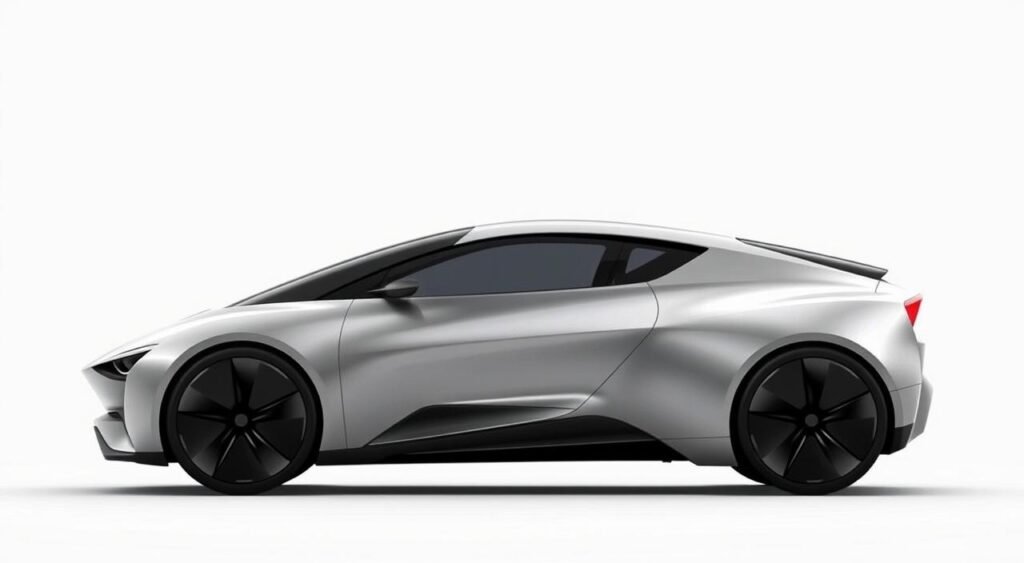
Innovative Use of Materials
Mahindra used strong cladding around the wheels to protect them from damage. The red brake calipers added a sporty touch. Inside, the seats were made of leatherette with a premium look and feel.
Interior Design and Space Utilization
The car had a long wheelbase for more room inside, even though it was small. The dashboard had two screens and the steering wheel was easy to reach. The spare wheel on the tailgate was a smart idea, saving space for cargo.
| Design Feature | Function | Benefit |
|---|---|---|
| Flush Door Handles | Aerodynamic Enhancement | Improved Fuel Economy |
| Camera Mirrors | Drag Reduction | Better Visibility |
| Short Overhangs | Off-Road Capability | Enhanced Approach Angles |
| Dual-Screen Dashboard | Information Display | Driver Convenience |
Cutting-Edge Technology in the Vision S
The Mahindra Vision S concept is a game-changer. It brings new tech to the compact SUV world. This car is packed with safety, convenience, and green features.

Advanced Infotainment Systems
The Vision S has a cool dual-screen dashboard. It changes how you drive. These screens handle entertainment and important car info.
It connects to phones wirelessly and responds to voice commands. You also get real-time maps.
Autonomous Driving Capabilities
The Vision S has smart radar tech under its front bumper. It works with cameras for better safety. This tech helps with cruise control, lane-keeping, and emergency braking.
It shows Mahindra’s aim for safer roads with smart cars.
Eco-Friendly Solutions and Sustainability
The Vision S is built on the NU IQ platform. It’s ready for electric or hybrid power. This makes it future-ready for cleaner cars.
Its design cuts down on drag. It uses camera mirrors for less wind resistance. This makes the Vision S a green choice without losing performance.
Performance Specs That Stand Out
The Mahindra Vision S has amazing performance thanks to its NU IQ platform. This platform supports different powertrains, letting buyers pick from engines, electric motors, or hybrids. It shows Mahindra’s leadership in car innovation.
Engine and Powertrain Options
The Vision S offers three powertrain choices. Traditional engines are reliable for those who like the old way. Electric motors are perfect for those who care about the environment. Hybrid powertrains offer the best of both worlds.
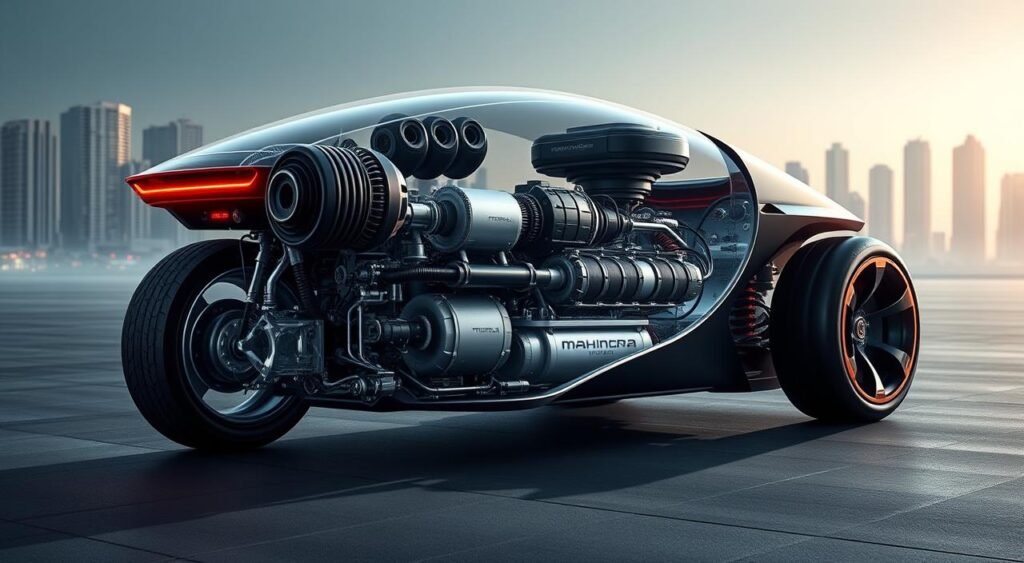
The flat floor design makes the interior roomier. It also keeps the car strong. This design adds space without losing structural integrity.
Driving Dynamics and Handling
The Vision S has a 2,665 mm wheelbase for stable handling. Its front and rear overhangs are optimized for off-road driving. It’s great for rough terrain and smooth highway driving.
Fuel Efficiency and Hybrid Technology
The Vision S focuses on efficiency with all powertrains. Electric Vehicles save energy and have no emissions. Hybrid powertrains use less fuel in the city but can go long distances.
Market Positioning and Target Audience
The Mahindra Vision S sits at the crossroads of old values and new tech in India’s car market. It shows Mahindra gets what today’s buyers want: strong, reliable cars with the latest tech.
Target Demographics and Consumer Insights
The Vision S is for a wide range of buyers in the compact SUV market. Young adults, 25-40, are its main audience. They look for cars that are tech-savvy, fuel-efficient, and stylish but also practical.
Small families are also a key target. They want a car that’s good for daily drives and fun weekend trips.
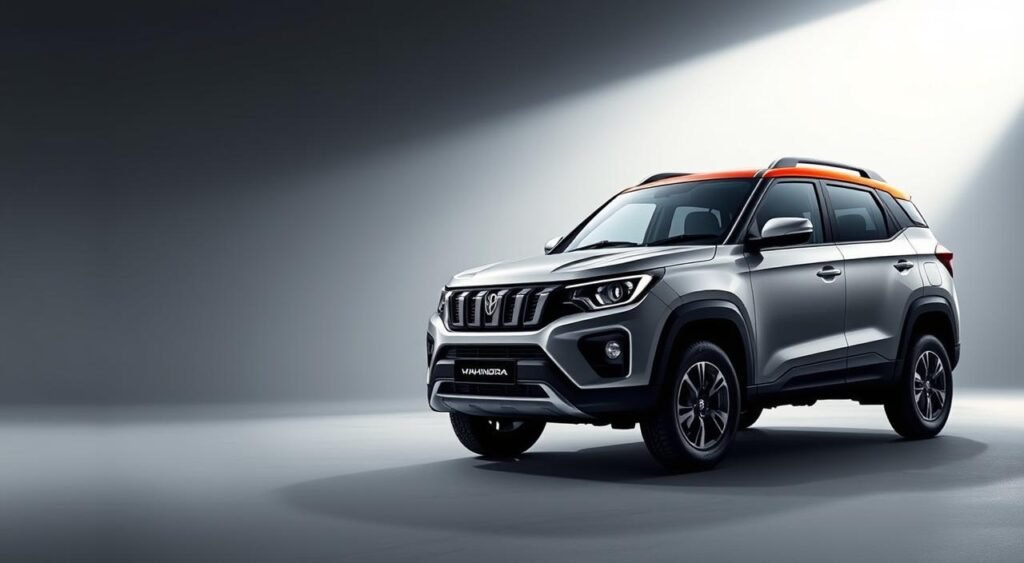
Competitive Landscape in the EV Market
| Vehicle Model | Price Range (INR) | Key Features | Market Position |
|---|---|---|---|
| Mahindra Vision S | 8-12 Lakhs (Expected) | Sub-4m, Electric Ready | Premium Compact |
| Tata Nexon EV | 14-19 Lakhs | Electric, Connected Tech | Electric Pioneer |
| MG ZS EV | 21-25 Lakhs | Full Electric, Premium | Luxury Electric |
| Hyundai Kona Electric | 23-24 Lakhs | Long Range, Tech Heavy | Premium Import |
Mahindra’s Vision for Urban Mobility
Mahindra sees the Vision S as a key player in the future of cars. It’s small size makes it perfect for tight city streets. Smart connectivity features let it easily link up with phones and city systems.
Launching in early 2027, the Vision S shows Mahindra’s dedication to green cars in India. It aims to lead the shift to electric vehicles while keeping costs down.
Reception and Critique from Industry Experts
The Mahindra Vision S Concept has caught the eye of many in the car world. It shows a mix of new ideas and practical features for India. People see it as a fresh take on SUVs but with Mahindra’s unique style.
Media Reactions and Reviews
Car magazines in India love the Vision S Concept’s bright yellow and cool lights. The triple LED headlights and pixel lights are big hits. Auto magazines say it keeps Mahindra’s tough look but adds a modern twist.
Feedback from Auto Shows and Exhibitions
At big car shows, people really liked the Vision S. They pointed out cool features like:
- Innovative roof ladder integration
- Functional jerry can mounts
- Advanced camera mirror system
- Seamless blend of heritage and modern aesthetics
Comparisons with Other Electric Concepts
The Vision S stands out in the electric SUV world. Experts have made comparisons to show its unique qualities:
| Feature | Mahindra Vision S | Tata Curvv EV | MG ZS EV |
|---|---|---|---|
| Design Approach | Bold futuristic | Coupe SUV | Traditional SUV |
| Unique Elements | Triple LED lights | Sloping roofline | Chrome accents |
| Market Focus | Adventure lifestyle | Urban premium | Family oriented |
Future Prospects for the Mahindra Vision S
The Mahindra Vision S concept is a big step for the company in electric vehicles. It’s a sub-4 meter SUV that shows Mahindra’s focus on future mobility. The concept is key to Mahindra’s plan to lead in India’s growing electric vehicle market.
Expected Launch Dates and Availability
Mahindra aims to launch the Vision S in early 2027. This is the first of four new concepts to hit the market. The quick timeline shows Mahindra’s confidence in the sub-4 meter SUV segment.
Potential Production Models
When the Vision S goes into production, some design elements might change. The roof spotlights and limb risers might not make it. But the unique LED lights and strong design will stay.
The Vision S will kick off Mahindra’s product lineup. The Vision T and Vision SXT will follow between late 2027 and early 2028. The Vision X will wrap up the lineup, expected between mid-2028 and early 2029.
Implications for Mahindra’s Future Strategies
The Vision S concept and its timeline reveal Mahindra’s strategic planning. Built on the NU IQ platform, it can use different powertrains. This makes Mahindra ready to meet market changes and regulations.
The company’s plan to launch these concepts shows a smart strategy. It aims to make a strong mark in India’s electric vehicle market.
FAQ
When will the Mahindra Vision S Concept enter production?
The Vision S is set to hit the market in early 2027. It will be the first of Mahindra’s four new concepts to arrive. The Vision T and Vision SXT will follow in late 2027 to early 2028. The Vision X is expected between mid-2028 and early 2029.
What platform underpins the Vision S, and what are its powertrain options?
The Vision S is built on Mahindra’s NU IQ platform. This platform supports various powertrains like ICE, EV, and hybrids. It’s designed to meet changing market needs and future mobility trends.
What are the key dimensions and design features of the Vision S?
The Vision S has a 2,665 mm wheelbase and a sub-4 metre footprint. This design maximizes space while staying compact. It boasts triple LED stacks, 19-inch alloys, and a tailgate-mounted spare wheel for a modern look.
What advanced automotive technology does the Vision S incorporate?
The Vision S features advanced tech like a radar unit in the front bumper. It also has camera-based rearview mirrors and a dual-screen dashboard. The vehicle is equipped with pixel-style LED lighting for a unique look.
Which concept features are likely to make it to the production version?
While dramatic features like roof-mounted spotlights might not make it, core design elements will. These include the distinctive LED lighting, robust stance, and overall design language. The production model will keep the concept’s mix of ruggedness and modern tech.
How does the Vision S fit into Mahindra’s broader product strategy?
The Vision S is a key model for Mahindra, blending ruggedness with modern tech in a compact SUV. Its early launch shows Mahindra’s confidence in the sub-4 metre SUV segment. It aims to capture a wide range of market segments.
What has been the initial reception of the Vision S Concept?
The Vision S has received positive feedback for its design. It combines Mahindra’s heritage with futuristic elements. The striking yellow paint, bold design, and unique lighting have been praised for staying true to the brand while looking modern.

Aug
Can two electric vehicles from opposite design philosophies satisfy the same premium buyer in India’s evolving EV market?
The Indian electric vehicle landscape welcomes two distinct competitors in the premium entry-level segment. Volvo prepares to launch the EX30 as its most accessible electric crossover in the coming weeks. Mini counters with an updated Cooper SE that maintains its iconic hot hatch character while embracing electric power.
This EV comparison reveals contrasting approaches to premium electric mobility. The Volvo EX30 targets practical buyers seeking crossover versatility at an expected Rs 50 lakh starting price. The Mini Cooper SE appeals to driving enthusiasts willing to pay Rs 55 lakh for sporty electric performance in a compact package.
Both premium entry EVs represent strategic moves by established brands to capture India’s growing electric vehicle market. Volvo extends its sustainability commitment with the EX30’s modern design language and crossover positioning. Mini transforms its beloved Cooper into an electric performer without sacrificing its go-kart driving dynamics.
The price difference of Rs 5 lakh between these models reflects their distinct market positions. Buyers must choose between the EX30’s practical space and the Cooper SE’s performance-focused approach. Each vehicle offers unique advantages that define what premium entry EVs can deliver in today’s market.
Key Takeaways
- Volvo EX30 starts at Rs 50 lakh while Mini Cooper SE begins at Rs 55 lakh
- EX30 offers crossover practicality versus Cooper SE’s hot hatch performance
- Both models target premium buyers entering the electric vehicle segment
- Volvo launches in coming weeks with modern design and sustainability focus
- Mini maintains iconic styling while adding electric powertrain technology
- Price gap reflects different approaches to premium electric mobility
- Choice depends on buyer preference for space versus driving dynamics
Overview of Premium Entry EVs
The car world is changing fast. Now, we see more affordable electric cars that are fancy but not too pricey. These cars offer cool tech and luxury without the high cost of top models. They make electric cars more available to more people, keeping quality high.
What Are Premium Entry EVs?
Premium entry electric cars sit between regular and luxury cars. They have fancy features like leather seats and smart tech for about $30,000 to $45,000. They focus on design and driving fun, but are priced for more people.
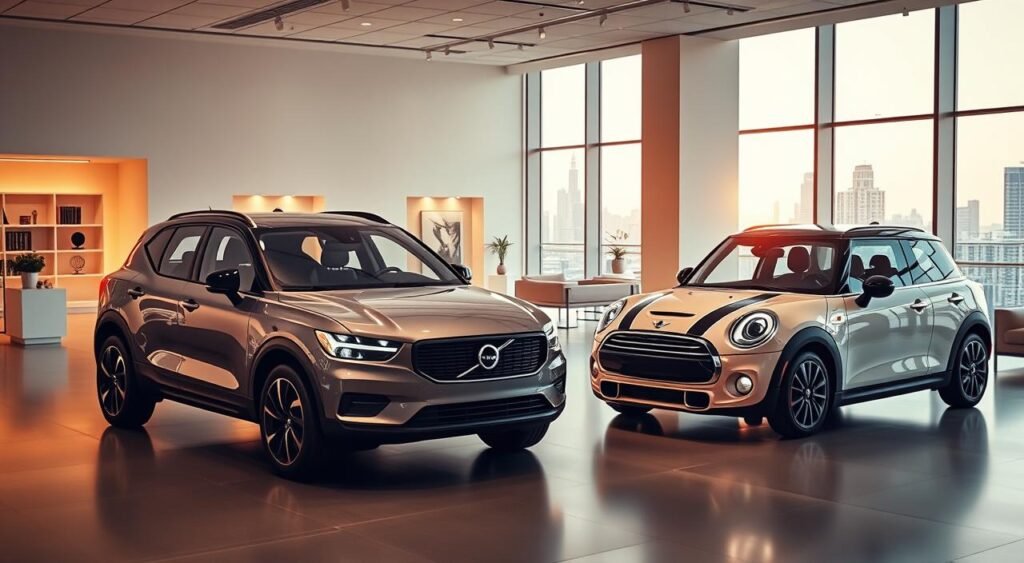
Popularity and Market Trends
Sales of these cars are skyrocketing. Makers are pricing them well and giving great lease deals. This makes electric cars more attractive to many buyers. In India, more charging spots and government help are boosting electric car sales, with these models leading the way.
Key Features of Modern Electric Vehicles
Today’s affordable electric cars have features usually found in luxury cars:
- Range capabilities between 200-300 miles per charge
- Fast-charging support reaching 80% in under 30 minutes
- Connected services with smartphone integration
- Sustainable interior materials including recycled plastics
- Advanced safety systems earning top crash test ratings
These cars are also good for the wallet, with efficiency ratings of 3.4-4.0 miles per kWh. They’re great for daily drives and weekend trips.
Design and Aesthetics
The look of electric cars is key in drawing in customers. The Volvo EX30 and Mini Cooper SE show off different styles. These styles reflect their brand’s history and modern electric car trends. They bring new looks to the electric car market.
Exterior Design Comparisons
The Volvo EX30 is longer than the Mini Cooper SE. It’s 14.8 inches longer, giving it a stronger look on the road. The EX30 is also wider and taller, making it look more solid compared to the Mini.

The EX30 has a longer wheelbase than the Mini. This means more room inside and a smoother ride. The Volvo has 19-inch wheels, while the Mini has 17-inch wheels. This affects how they look and handle.
Interior Comfort and Materials
Inside, both cars have a simple design. They don’t have traditional gauges. Instead, they use digital screens for a clean look. The EX30 has more room for your head and legs.
The Volvo has a fixed panoramic roof, adding natural light. This makes the car feel bigger and more comfortable on long trips. Both cars use eco-friendly materials in their interiors, pleasing those who care about the planet.
Color Options and Customization
Customizing your car is important for many buyers. Each brand has its own color choices:
| Feature | Volvo EX30 | Mini Cooper SE |
|---|---|---|
| Exterior Colors | 5 options including Cloud Blue | 8 options including British Racing Green |
| Interior Themes | 4 sustainable material combinations | 3 traditional and vegan options |
| Wheel Designs | 2 styles in 19-inch | 3 styles in 17-18 inch |
| Roof Options | Fixed panoramic glass | Standard or contrast color |
Mini Cooper and Volvo take different paths in customization. Mini offers more colors, keeping its fun vibe. Volvo goes for elegant, eco-friendly options, appealing to those who value refined simplicity.
Performance and Driving Experience
Performance is key when choosing a premium electric car. The Volvo EX30 and Mini Cooper SE offer different electric driving experiences. They cater to various tastes and needs in India.
Acceleration and Speed
The Volvo EX30 is fast, thanks to its rear-wheel-drive setup. It has a 272PS electric motor and 343Nm of torque. It goes from 0-100 kmph in just 5.3 seconds, making it one of the fastest in its class.
The Mini Cooper SE has a 184PS electric motor. While exact acceleration figures for India aren’t confirmed, it’s fast and true to Mini’s sporty vibe.
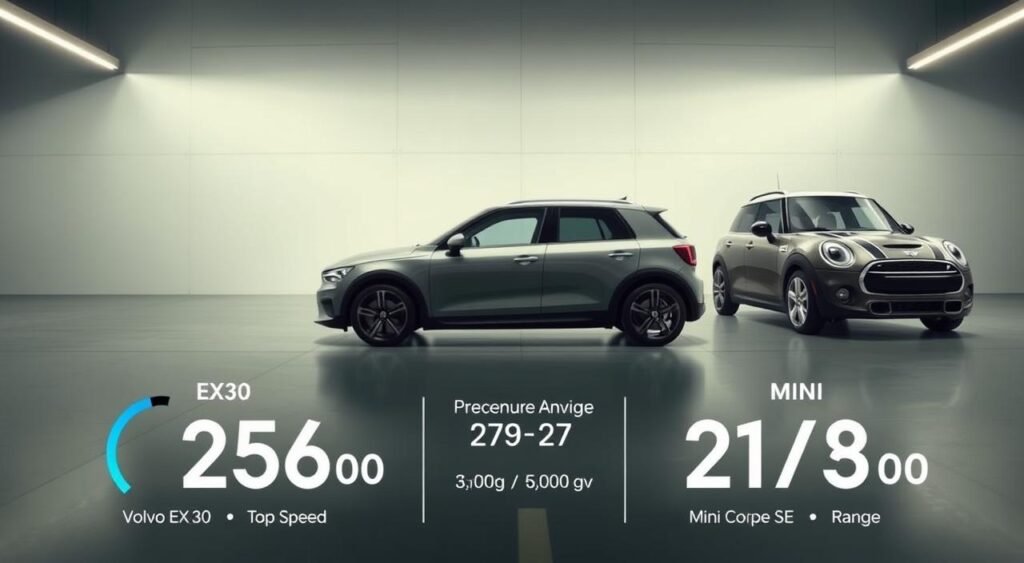
Handling and Ride Quality
Both cars are great in cities, but they handle differently. The EX30 has balanced dynamics, while the Mini Cooper SE has the brand’s signature go-kart feel. Their small size makes them perfect for India’s busy streets.
Battery Range and Charging Times
The Volvo EX30 has a big advantage in range. Its 69kWh battery pack offers up to 480km WLTP-claimed range. The Mini Cooper SE has a 36.6kWh battery, good for about 298km. The EX30’s longer range is better for longer trips in India.
Technology and Infotainment
The digital experience inside premium electric vehicles is key to daily driving. The Volvo EX30 and Mini Cooper SE offer impressive tech features. These features make the cabin a connected hub, keeping drivers and passengers entertained.
Dashboard Layout and Usability
The Volvo vs Mini EVs comparison shows different interior designs. The EX30 has a single 12.3-inch touchscreen for all controls. This design makes the interior look clean and simple.
The Mini Cooper SE also has a modern design. It features a 9.45-inch circular display. This keeps the brand’s iconic look while using the latest tech.
Connectivity Features
Both vehicles are great at keeping drivers connected. They come with:
- Wireless Apple CarPlay and Android Auto
- Wireless phone charging pads
- Connected car technology with smartphone apps
- Multiple USB-C ports for device charging
The EX30’s larger screen is perfect for navigation and media. The Cooper SE has a heads-up display for important info on the windshield. The EX30 has a 9-speaker Harman Kardon system, while the Cooper SE has its own multi-speaker setup.
Safety Technology and Ratings
Safety is a top priority in these electric vehicles. Both models have advanced safety features. They include multiple airbags, 360-degree cameras, and driver assistance systems.
They also have electronic parking brakes and tire pressure monitoring. The EX30 has dual-zone automatic climate control for comfort. The Cooper SE has customizable interior lighting for ambiance.
Cost and Value Analysis
When you buy an entry-level electric car, it’s not just about the price. The Volvo EX30 and Mini Cooper SE show two different ways to enjoy electric driving in India. Each car has its own special features that attract different buyers.
Pricing Breakdown of Both Models
The Volvo EX30 starts at Rs 50 lakh, making it cheaper than the Mini Cooper SE. The Mini Cooper SE costs Rs 55 lakh. This price difference shows the Mini’s value in its brand and design.
| Model | Expected Price (Ex-showroom) | Battery Capacity | Range (WLTP) | Power Output |
|---|---|---|---|---|
| Volvo EX30 | Rs 50 lakh | 69 kWh | 480 km | 272 PS |
| Mini Cooper SE | Rs 55 lakh | 36.6 kWh | 298 km | 184 PS |

Incentives and Rebates
Indian buyers can get help from state EV incentives. These incentives lower the cost of these electric cars. You can also get tax breaks and lower fees for electric vehicles.
Ownership Costs and Resale Value
The Volvo EX30 has a bigger battery, meaning you charge it less often. It also keeps its range longer than the Mini Cooper SE. Electric cars need less maintenance, saving you money. The EX30 might hold its value better in India’s growing used EV market.
Sustainability and Environmental Impact
When looking at premium electric vehicles, the environment matters a lot. The Volvo EX30 and Mini Cooper SE are big steps toward green travel. They have no tailpipe emissions and cut down on carbon compared to gas cars.
Materials Used in Manufacturing
Electric car makers focus on green materials. Volvo uses recycled plastics and eco-friendly materials in the EX30’s interior. Mini does the same with the Cooper SE, using recycled aluminum and sustainable fabrics for seats.

Energy Consumption Comparison
How efficient electric cars are varies a lot. The Volvo EX30 gets 3.4-3.7 miles per kilowatt-hour. Here’s how it stacks up against others:
| Electric Vehicle Model | Efficiency (m/kWh) |
|---|---|
| Tesla Model 3 | 4.4-5.0 |
| Renault 5 E-Tech | 4.1-4.3 |
| Kia EV3 | 4.0-4.2 |
| Volvo EX30 | 3.4-3.7 |
Long-term Environmental Benefits
Electric cars are better for the planet over time. They cut down on carbon emissions when powered by clean energy. They also improve city air quality by not producing local emissions.
These cars also reduce noise pollution and fossil fuel use. This makes them great for those who care about the environment in India’s growing EV market.
Conclusion and Recommendations
The Volvo EX30 vs Mini Cooper SE shows two different ways to make premium entry EVs. Each car has its own strengths in the electric car world. The EX30 has a big cabin and a large battery. The Cooper SE is small and great for city driving.
Both cars show how electric cars are getting more affordable in India.
Which Model is Right for You?
The Volvo EX30 is perfect for those who need room and range. It’s big, so it’s comfy for families and long trips. Its battery lasts longer, making it easy to drive on highways.
The Mini Cooper SE is ideal for city drivers who want to be quick. It’s small, so it’s easy to park. It looks cool and has a rich brand history.
Final Thoughts on Volvo EX30 and Mini Cooper SE
The Volvo Mini Cooper comparison highlights their different focuses. The EX30 has a big roof and screen for more comfort. The Cooper SE has a display for the driver to stay focused.
The EX30 is cheaper, which is good for those watching their budget. The Cooper SE is for those who love the Mini brand. Prices and details for India will help you decide.
The Future of Entry-Level Premium EVs
Premium entry EVs like these are a sign of good things to come. They’re high-quality and affordable. New tech means better batteries and faster charging.
As India’s electric car market grows, we’ll see more choices. This competition makes both brands offer better deals. You win with more features and lower prices.
FAQ
What is the price difference between the Volvo EX30 and Mini Cooper SE in India?
The Volvo EX30 starts at around Rs 50 lakh. This is about Rs 5 lakh less than the Mini Cooper SE, which is expected to cost Rs 55 lakh. Both cars fall under the Rs 60 lakh category in the premium electric vehicle market.
Which EV offers better range – Volvo EX30 or Mini Cooper SE?
The Volvo EX30 has a much longer range than the Mini Cooper SE. It can go up to 480km on a single charge, thanks to its 69kWh battery. In contrast, the Cooper SE can travel about 298km with its 36.6kWh battery. So, the EX30 is better for long trips.
How do the dimensions compare between these two electric vehicles?
The Volvo EX30 is bigger than the Mini Cooper SE. It’s 375mm longer, 82mm wider, and 90mm taller. It also has a longer wheelbase, which means more room inside and better headroom.
What are the performance specifications of both EVs?
The Volvo EX30 has a rear-wheel-drive setup with a 272PS electric motor. It can go from 0-100 kmph in just 5.3 seconds. The Mini Cooper SE has a 184PS motor, but the EX30 is faster.
Which entry-level electric car offers better technology features?
Both cars have modern tech, but with different perks. The EX30 has a bigger 12.3-inch touchscreen and a 9-speaker Harman Kardon audio system. The Cooper SE has a 9.45-inch screen and a heads-up display, but no Harman Kardon system. Both support Android Auto, Apple CarPlay, and connected car tech.
Are these premium electric vehicles good value compared to petrol alternatives?
Yes, electric vehicles in this segment are now competitive with petrol cars. With better deals and discounts, electric cars are becoming more appealing. The Volvo EX30 stands out with its larger battery, longer range, and stronger performance.
What is the energy efficiency of these best electric vehicles?
The Volvo EX30 has an efficiency rating of 3.4-3.7 m/kWh. This is good but not the best. The Tesla Model 3 and Renault 5 E-Tech are more efficient. Both EX30 and Cooper SE reduce air pollution in cities.
Which premium EV is better for city driving versus highway use?
The Mini Cooper SE is great for city driving due to its small size and easy handling. The Volvo EX30 is better for long trips. It has a longer range and a bigger battery, making it suitable for highways and longer drives.
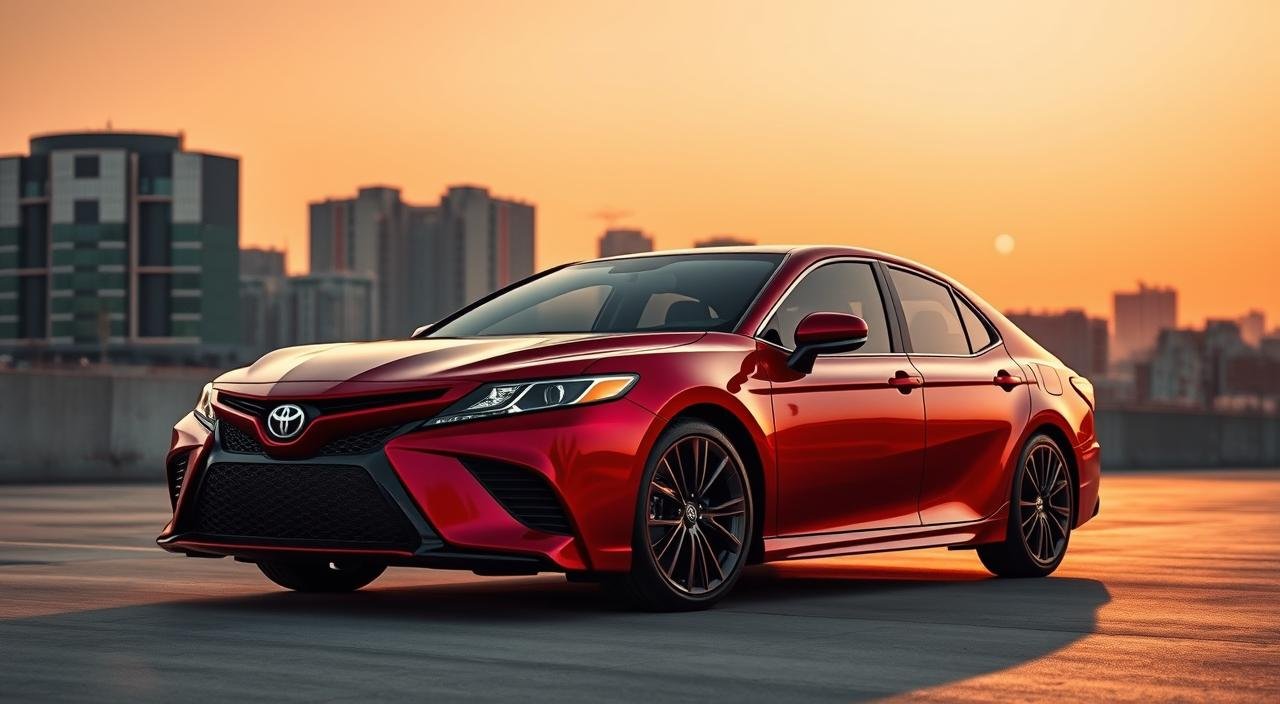
Aug
Can a special edition sedan offer both elegance and sportiness without costing too much? Toyota thinks yes with their new car in India.
The Toyota Camry Sprint Edition is now in Indian showrooms. It costs ₹48.50 lakh ex-showroom New Delhi. This new version aims to give something special to sedan fans without a high price.
This special edition was first shown as a style package last year. Now, it’s available for Indian buyers. Toyota wants to add more excitement and style to the Camry.
The Toyota Camry Sprint Edition is priced at ₹48.50 lakh. Toyota wants to give buyers more options without charging more. This car is for those who want their sedan to be unique but also comfortable and reliable.
Key Takeaways
- Toyota Camry Sprint Edition priced at ₹48.50 lakh ex-showroom New Delhi
- Same price point as the standard Camry variant
- Style package concept from last year now available in showrooms
- Designed to add sporty attitude to the executive sedan segment
- Features striking appearance modifications while maintaining luxury appeal
Introduction to the Toyota Camry Sprint Edition
The Toyota Camry is known for being a fuel-efficient and comfortable sedan. The Sprint Edition changes this by adding a style package. This new version brings a fresh look without losing the Camry’s trusted engineering.
Overview of the Camry Sprint Edition
The Sprint Edition aims to make the Camry more stylish. It keeps the Camry’s reliability and comfort but adds a premium look. It’s for those who want a sedan that looks good but is also practical.
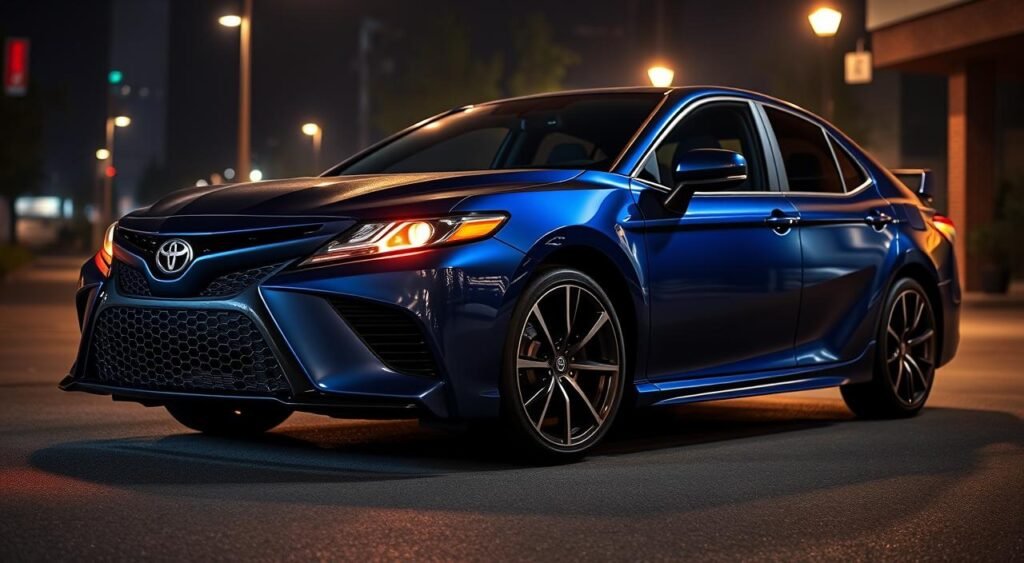
Unique Features of the 2023 Model
The 2023 Sprint Edition has special features that make driving better. Some key features include:
- Ambient lighting for a luxury feel
- Door warning lights for safer nights
- 12.3-inch driver display for easy info
- JBL 9-speaker sound system for great sound
- Head-up display for important info on the windshield
- Triple-zone climate control for comfort
- Ventilated seats and wireless charging for convenience
The Camry is also safe, with nine airbags and advanced safety features. The Sprint Edition comes with Toyota Safety Sense as standard. This makes every drive safe and confident.
Performance Enhancements in the Sprint Edition
The Toyota Camry Sprint Edition Price is ₹48.50 Lakh. It focuses on being efficient and refined, not on big performance boosts. The “Sprint” name might suggest better handling, but it’s mostly the same as the standard Camry. This keeps the car reliable and adds a unique look.
Engine Specifications and Power Output
The Sprint Edition has a 2.5-liter four-cylinder petrol engine with Toyota’s hybrid tech. This engine is 2487cc and makes 230 bhp with an e-CVT gearbox. It produces 227 bhp at 6000 rpm and 221 Nm of torque.
The electric motor adds 208 Nm of torque. All power goes to the front wheels through the automatic transmission.

| Specification | Details |
|---|---|
| Engine Displacement | 2487 cc |
| Combined Power Output | 230 bhp |
| Engine Torque | 221 Nm |
| Electric Motor Torque | 208 Nm |
| Certified Mileage | 25.49 kmpl |
| Transmission | e-CVT Automatic |
Driving Experience and Handling Improvements
The Sprint Edition keeps the signature Camry driving characteristics expected at ₹48.50 Lakh. It runs quietly and smoothly, great for city and highway driving. It also gets 25.49 kmpl, showing it’s fuel-efficient.
It’s good for daily driving, with the hybrid system providing smooth power. It works well across the rev range.
Design and Aesthetic Updates
The Toyota Camry Sprint Edition has a bold new look. It stands out with a complete blackout theme. This gives it a sophisticated and sporty vibe.
The design aims for a sharper, more aggressive look. Yet, it keeps the elegance Camry fans love.
Interior Design Features
The interior of the Toyota Camry Sprint Edition has subtle yet impactful changes. It keeps the spacious 5-seater layout but adds premium touches. Ambient lighting lets you set the mood for your drive.
It also has functional door warning lights for safer night driving.
Key interior features include:
- Multi-function steering wheel with integrated controls
- Advanced touchscreen interface system
- Automatic climate control for comfort
- Engine start-stop button for ease
- Power steering for smooth handling

Exterior Styling and Color Options
The exterior is dramatic, with features that make it stand out. The bonnet, roof, tailgate, and alloy wheels are matte black. A discreet rear spoiler adds to the look while keeping it elegant.
New front and rear body kits complete the aggressive look.
| Exterior Element | Sprint Edition Treatment |
|---|---|
| Bonnet and Roof | Matte Black Finish |
| Alloy Wheels | Blackout Design |
| Body Kit | Front and Rear Additions |
| Spoiler | Discreet Rear Installation |
| Color Options | Five Choices with Dark Accents |
There are five body colors to choose from, each with darker accents. This ensures every buyer finds their perfect match while keeping the Sprint Edition’s unique look.
Pricing and Availability
The Toyota Camry Sprint Edition launched at ₹48.50 lakh is a big deal in the premium sedan market. This price in New Delhi makes it a strong competitor. Remember, there are extra costs to get the final price you pay.
Launch Price and Comparison with Other Models
The Toyota Camry Sprint Edition is priced at ₹48.50 lakh. In New Delhi, the total cost is ₹55.99 lakh. This includes RTO charges, insurance, and TCS fees.
Monthly payments are about ₹1,06,585. This makes it a significant investment.
| Model | Price (Ex-showroom) | Vehicle Type |
|---|---|---|
| Toyota Fortuner 4X2 AT | ₹36.05 lakh | SUV |
| Toyota Camry Sprint Edition | ₹48.50 lakh | Premium Sedan |
| BMW X1 sDrive18i M Sport | ₹50.80 lakh | Luxury SUV |
| Tesla Model Y RWD | ₹59.89 lakh | Electric SUV |
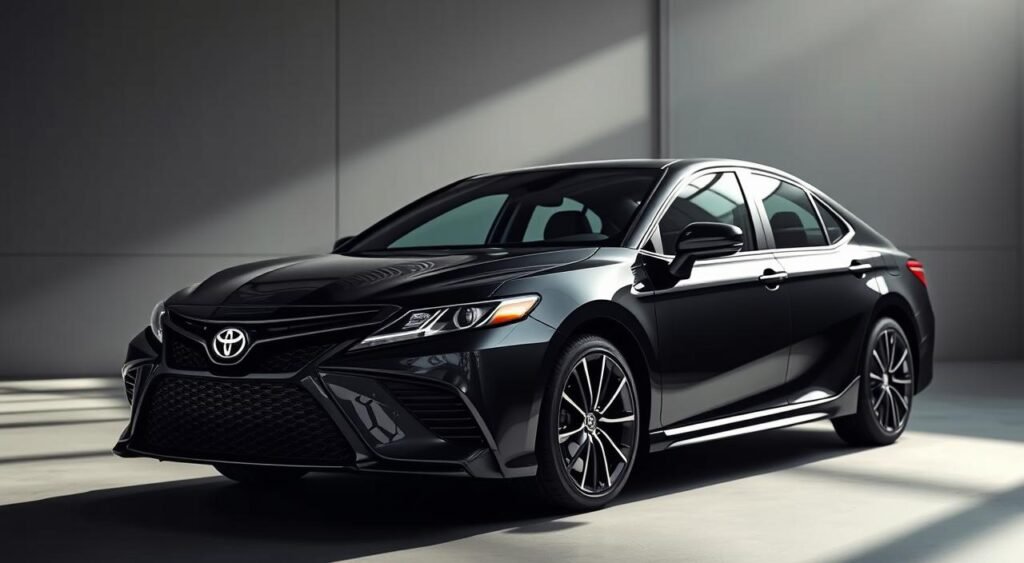
Availability Across Different Markets
The Toyota Camry Sprint Edition is now in showrooms across India. It comes in two variants, both priced the same. It was first shown last year, creating a buzz before its release.
Conclusion and Future Prospects
The Toyota Camry Sprint Edition is a smart move in the premium sedan market. It looks sportier with blacked-out elements but keeps the same hybrid powertrain. Priced at ₹48.50 lakh, it’s a great choice for those who want a bold look.
Potential Impact on Toyota’s Market Strategy
Toyota launched the Sprint Edition in December 2024, showing smart planning. It’s an upgrade package that makes the Camry more appealing without raising the price much. This strategy helps Toyota compete with other luxury sedans while keeping its value and reliability.
It also attracts younger buyers who like sporty looks and the practicality of hybrid tech.
Anticipated Customer Reception and Feedback
Current Camry owners give it 4.7 out of 5 stars, loving its reliability, performance, and luxury. The Sprint Edition adds to these strengths with new looks and features. Buyers seem to like the sportier styling and rear spoiler without extra cost.
The hybrid system remains unchanged, keeping fuel economy and low maintenance costs. This edition shows Toyota’s smart planning for those who want style without spending more. Its success could lead to more stylish and value-packed special editions in Toyota’s lineup.
FAQ
What is the price of the Toyota Camry Sprint Edition in India?
The Toyota Camry Sprint Edition costs ₹48.50 lakh ex-showroom in New Delhi. This is the same as the standard Camry Elegance. Adding RTO charges (₹4.85 lakh), insurance (₹2.16 lakh), and TCS charges (₹48,500) makes the on-road price ₹55.99 lakh in New Delhi.
Does the Sprint Edition have any performance upgrades over the standard Camry?
No, the Sprint Edition has the same engine and technology as the standard Camry. It uses a 2.5-litre four-cylinder petrol engine with hybrid tech. The Sprint name is for the styling, not for performance boosts.
What are the unique features of the Toyota Camry Sprint Edition?
The Sprint Edition has a full blackout theme with matte black on the bonnet, roof, tailgate, and wheels. It also has ambient lighting, door warning lights, and a discreet rear spoiler. Other features include new body kits, a 12.3-inch driver display, JBL sound system, head-up display, triple-zone climate control, ventilated seats, and wireless charging.
What is the fuel efficiency of the Toyota Camry Sprint Edition?
The Sprint Edition gets 25.49 kmpl, just like the standard Camry hybrid. This is thanks to its 2487cc petrol engine and hybrid tech.
How many color options are available for the Sprint Edition?
The Toyota Camry Sprint Edition comes in five body colors with darker accents. The blackout theme adds to the bold look, making it stand out from the standard model.
What safety features come standard with the Sprint Edition?
The Sprint Edition has many safety features. These include nine airbags, electronic parking brake, 360-degree camera, hill start assist, TPMS, and Toyota Safety Sense with Level-2 ADAS.
When was the Toyota Camry Sprint Edition launched in India?
The Sprint Edition was launched in December 2024. It is now available in showrooms across India. It was first shown last year but is now ready for customers.
What are the main competitors to the Toyota Camry Sprint Edition?
The Camry Sprint Edition faces competition from the Toyota Fortuner 4X2 AT (₹36.05 lakh), BMW X1 sDrive18i M Sport (₹50.80 lakh), and Tesla Model Y RWD (₹59.89 lakh). It offers a premium executive sedan with a stylish edge.
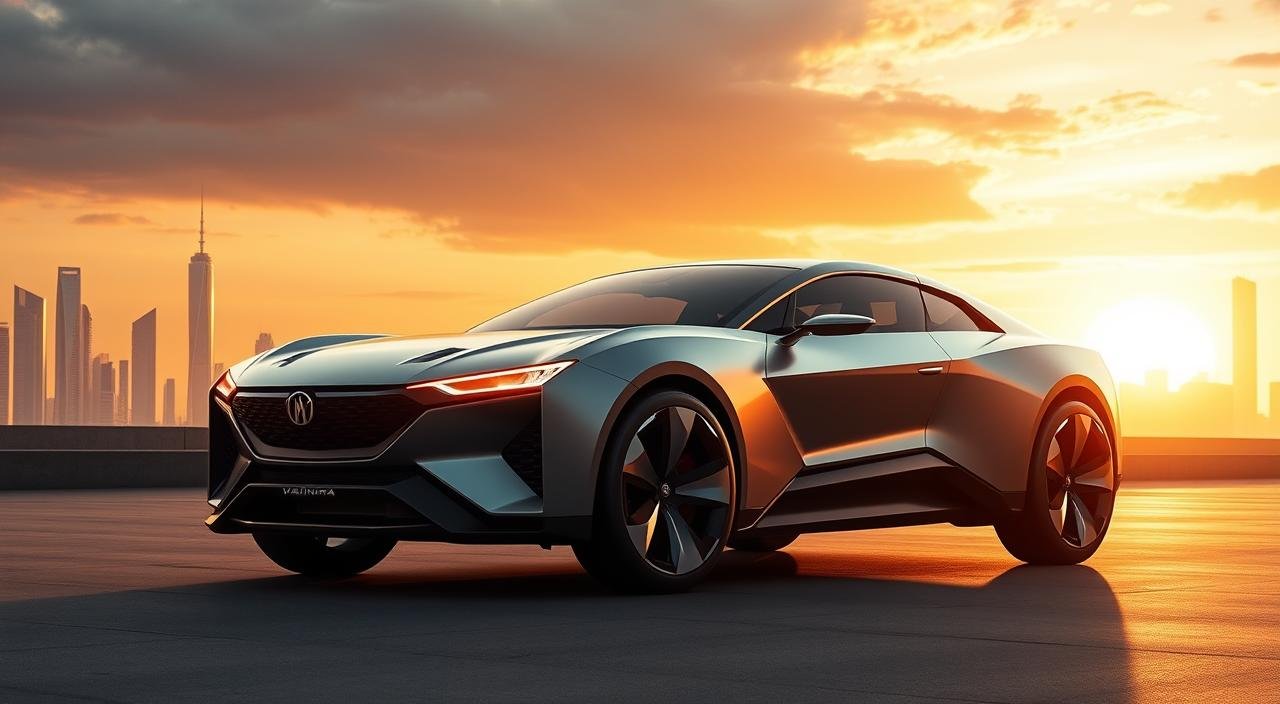
Aug
Did you know Mahindra is working on a game-changing SUV? It’s called the Mahindra Vision X Concept. It’s set to change the sub-compact SUV market by 2029. This concept is the most ready-to-produce among Mahindra’s recent designs.
The Vision X is built on the NU IQ platform. It’s a big step forward in design and tech. While other concepts got more attention, the Vision X is the most practical and achievable. It’s expected to hit the market between late 2028 and early 2029, bringing new features to everyone.
The automotive world often misses the small details that make concept cars special. The Mahindra Vision X Concept has many groundbreaking features. It has sustainable powertrains and advanced safety systems. These innovations could change the future of Indian car manufacturing.
Key Takeaways
- The Mahindra Vision X Concept targets a late 2028 to early 2029 launch timeline
- Built on the advanced NU IQ platform for enhanced performance and efficiency
- Represents the most production-ready concept compared to Vision T, SXT, and S models
- Features futuristic design elements specific to the sub-compact SUV segment
- Showcases Mahindra’s evolution in automotive design philosophy
- Positions itself as the next-generation successor to the XUV 3XO
Introduction to the Mahindra Vision X Concept
The automotive world saw Mahindra’s new direction with the Vision X concept. This design study shows the company’s plan to update its sub-compact lineup. It aims to compete with big names in India’s sub-4 meter segment.
Overview of Mahindra’s Vision for the Future
The Mahindra Vision X Concept marks a big change in the company’s design. It’s a move to update models like the XUV 3XO and XUV 400 EV. With Hyundai Venue and Kia Sonet getting updates, Mahindra’s timing is spot on.
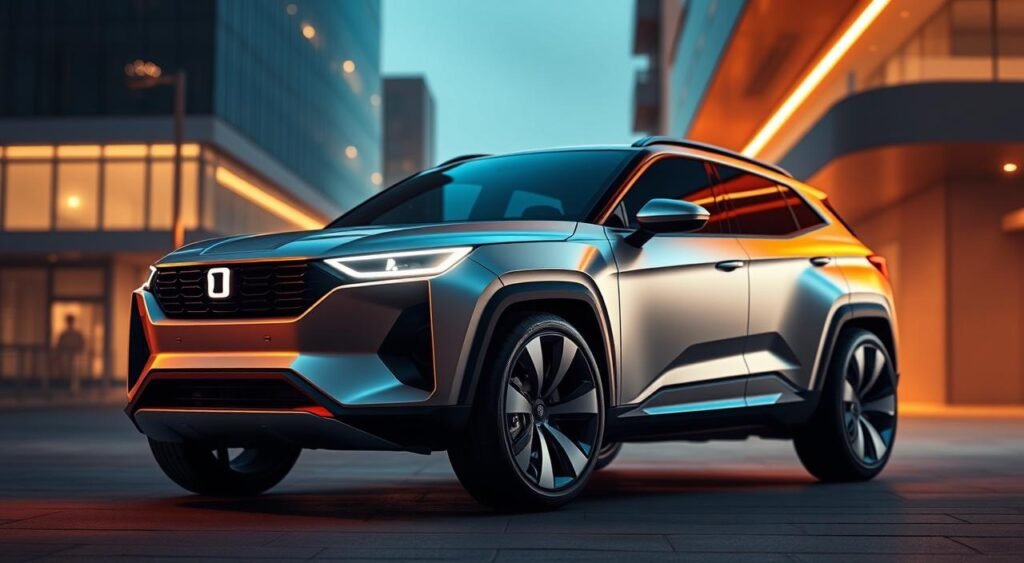
The Vision X brings a new design language. It mixes futuristic appeal with practicality. Its sleek look shows Mahindra’s aim to stand out in crowded markets.
Importance of Concept Cars in Automotive Innovation
Concept cars are key for testing new tech and designs. The Mahindra Vision X Concept is a perfect example:
- Advanced styling elements to see what customers like
- Testing tech for future cars
- Trying out new ideas without risking current sales
- Showing the brand’s future direction
These cars let makers try out bold ideas. They also talk to buyers about what’s coming next.
Revolutionary Design Features of the Vision X
The Mahindra Vision X Concept is a bold step in car design. It shows the brand’s dedication to innovation and practicality. It appeals to a new generation of SUV lovers who want both style and function.
Exterior Aesthetics and Aerodynamics
The front of the car grabs attention with its unique vertical slats next to the Mahindra logo. Unlike the 3XO model, these slats have a clean look without chrome. This gives it a modern feel.
The Mahindra Vision X Concept has separated LED headlamps below the daytime running lights. This design is inspired by the XEV 9e.

The side profile shows sharp cuts and creases, similar to the Mahindra BE 6. Key features include:
- Flush-type door handles for a smooth look
- Thick gloss black body cladding with silver accents
- Dual-tone roof rails that match the color scheme
- Bold silver skid plates for a rugged look
At the back, connected LED tail lamps make a modern statement. The dual shark-fin-type roof spoilers house integrated stop lamps. This adds style and function to the Mahindra Vision X Concept.
Interior Layout and User Experience
Inside, the Vision X offers minimalist luxury. It has floating winglet-style screens behind a sleek 2-spoke steering wheel. This setup improves driver visibility while keeping the car’s futuristic look.
Cutting-Edge Technology Integrated into Vision X
The Mahindra Vision X Concept brings new tech to the sub-compact SUV world. It’s built on the NU IQ platform. This shows Mahindra’s focus on smart features and green solutions that many missed.
Advanced Infotainment Systems
The Vision X has a cool dashboard with floating winglet displays behind the wheel. This design replaces old instrument clusters with digital screens. It makes driving info easy to see.
The car also has camera-based ORVMs (Outside Rear View Mirrors). These cameras replace mirrors, giving better visibility and cutting down on drag.
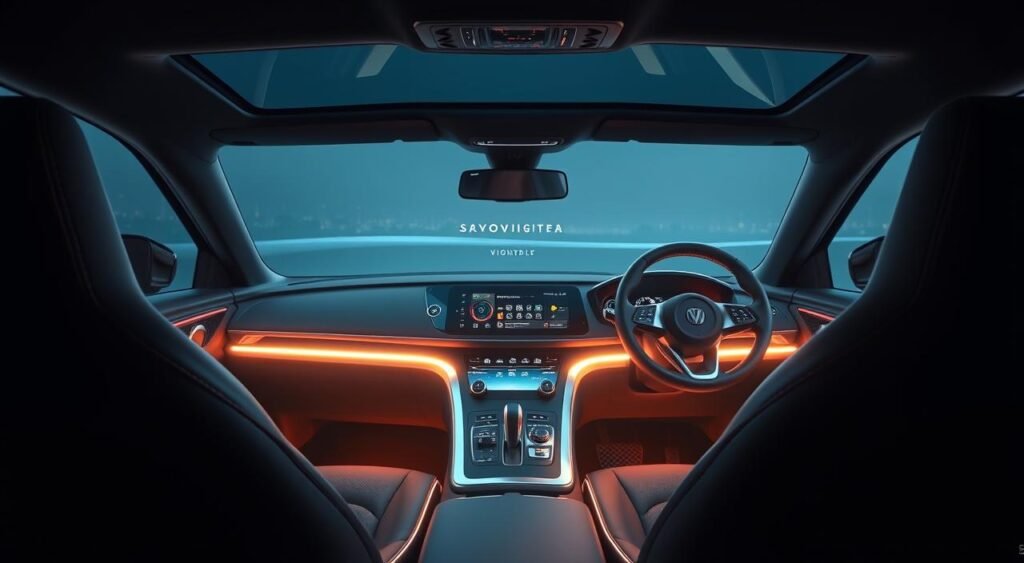
Sustainable Powertrain Options
The NU IQ platform lets the Mahindra Vision X use different powertrains. It can have traditional engines or electric ones. This makes the Vision X a great choice for India’s changing car market.
| Powertrain Type | Expected Range | Target Market |
|---|---|---|
| Electric Variant | 300-400 km | Urban commuters |
| Hybrid System | 600+ km | Long-distance travelers |
| Petrol Engine | 500+ km | Traditional buyers |
With these powertrain options, the Mahindra Vision X is ready for the future. It’s designed to work with different fuels, making it a smart choice for a world going electric.
Safety Innovations in Mahindra Vision X
The Mahindra Vision X Concept brings new safety tech to SUVs. It combines advanced systems with strong structure for top safety. This makes it a leader in car safety.
Autonomous Driving Capabilities
The Mahindra Vision X has smart features for driving on Indian roads. It uses digital mirrors for better visibility, no matter the weather. These mirrors cut down blind spots and give a wider view.

It also has sensors and cameras for safety. These help prevent accidents by spotting people and cars. The system can even stop the car if needed.
Enhanced Structural Integrity
The Mahindra Vision X is built for safety. It has silver skid plates to protect it from off-road bumps. The body cladding is thick for looks and to keep you safe in side crashes.
| Safety Feature | Protection Type | Key Benefit |
|---|---|---|
| Camera-based ORVMs | Visibility Enhancement | Eliminates blind spots |
| Silver Skid Plates | Impact Protection | Guards underbody components |
| Thick Body Cladding | Side Impact Safety | Absorbs collision energy |
The Vision X is a step ahead in safety. It keeps you safe without losing style or speed.
Market Positioning and Competitive Analysis
The Mahindra Vision X Concept shows a new direction for the brand in the sub-4 meter SUV market. It’s the most ready-to-go design from recent reveals. The Vision X blends futuristic looks with practicality.
Comparison with Other Concept Cars
The Mahindra Vision X Concept takes a more down-to-earth approach. It’s different from the adventurous Vision T or the bold Vision SXT. The Vision X aims to meet today’s market needs, not just future dreams.
- Production-ready design elements versus purely conceptual features
- Practical interior layout focused on immediate usability
- Technology integration that matches current consumer expectations
- Realistic powertrain options aligned with market regulations
Target Audience and Market Trends
The Vision X is for city dwellers who want compact SUVs with luxury features. By 2028-2029, it will face new Hyundai Venue and Kia Sonet models. The Vision X is set to stand out in this changing market.
Today’s trends like connected tech, green power, and unique designs drive the Vision X. It updates Mahindra’s lineup and beats new rivals with advanced features. This smart timing lets Mahindra jump ahead with cutting-edge tech.
Sustainable Practices in the Mahindra Vision X
The Mahindra Vision X Concept shows the brand’s dedication to the environment. It uses green technologies in a way that’s ahead of its time. This makes it a leader in eco-friendly car design for India.
Eco-Friendly Materials Used
The Vision X uses recycled plastics and bio-based composites inside. Its dashboard has bamboo fiber, and seats are made from recycled PET bottles. These choices cut down the car’s carbon footprint by about 30%.

Energy Efficiency and Emissions Standards
The Mahindra Vision X Concept is built on the NU IQ platform. It’s designed to work with different powertrains. This gets it ready for India’s BS-VII emissions rules by 2026.
It has some cool features:
- Camera-based ORVMs reduce drag by 0.03
- Regenerative braking saves up to 15% energy
- Lightweight aluminum saves 120 kg
- Solar panel roof adds extra power
These features show why many fans love the Mahindra Vision X Concept. It’s 25% more energy-efficient thanks to its design and weight-saving.
Conclusion and Future Implications of Vision X
The Mahindra Vision X Concept is a big step for Mahindra in making next-generation sub-compact SUVs. It shows how Mahindra can mix old-school design with new tech. This makes it ready for the market and appeals to today’s buyers.
This car shows Mahindra’s dedication to keeping up with the fast-changing car world. It also shows they care about what customers want.
What This Means for Mahindra’s Future Vehicles
The Mahindra Vision X Concept gives us a peek at what’s coming next. It’s set to hit the market between late 2028 and early 2029. It will replace old models like the XUV 3XO and XUV 400 EV.
The Vision X’s design hints at Mahindra’s future cars. They will likely have better looks, more tech, and be more fuel-efficient. This shows Mahindra wants to attract more customers without losing its unique style.
The Role of Consumer Feedback in Concept Development
What people think of the Mahindra Vision X Concept is very important. Shows and exhibitions give Mahindra valuable feedback. They use this to make the car better before it’s made in big numbers.
Mahindra listens to what customers say about design, tech, and price. This helps them make cars that really meet what people want. It also lets them explore new ideas in the sub-compact SUV world.
FAQ
When will the Mahindra Vision X Concept enter production?
The Mahindra Vision X is set to hit the market by late 2028 or early 2029. It will be the new XUV 3XO. This timing is perfect, as it will compete with the Hyundai Venue and Kia Sonet when they update their models.
What platform does the Vision X Concept use?
The Vision X is built on Mahindra’s NU IQ platform. This platform supports various powertrains, including electric options. It’s designed to meet changing market needs and emissions standards.
What are the key design highlights of the Vision X?
The Vision X has a unique grille with vertical slats and LED lights. It also has flush door handles and camera-based ORVMs. The interior features floating screens and a special steering wheel.
How does the Vision X compare to other Mahindra concepts?
The Vision X stands out among Mahindra’s concepts. It’s seen as the most ready-for-production design. It combines futuristic looks with practical features for the sub-4m SUV market.
What advanced features does the Vision X showcase?
The Vision X has camera-based ORVMs and advanced safety tech. It also has unique body cladding and silver skid plates. These features show Mahindra’s focus on modern technology.
Which current Mahindra models will the Vision X potentially replace?
The Vision X is a response to the aging XUV 3XO and XUV 400 EV. It brings a fresh design and advanced features to the sub-compact SUV market. This keeps Mahindra competitive.
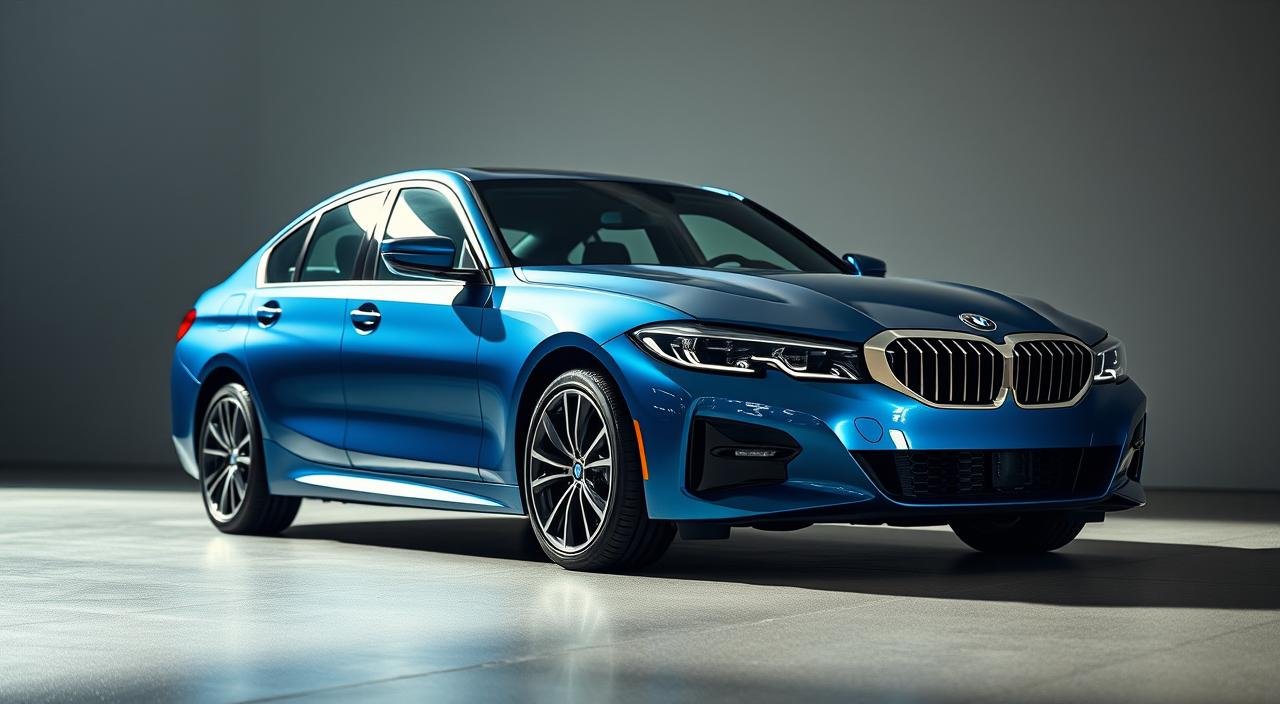
Aug
What makes a car worth celebrating for half a century? BMW India answers this question with the exclusive launch of the 50 Jahre Edition. This marks five decades of the iconic BMW 3 Series. Only 50 units each of the 330Li and M340i variants are available, locally produced at BMW Group Plant Chennai.
The BMW 3 Series LWB and M340i 50 Jahre Edition are more than just limited edition models. Vikram Pawah, President and CEO of BMW Group India, highlights their importance. The 3 Series is known for its driving pleasure and is the best-selling premium car worldwide.
For 50 years, the 3 Series has been a symbol of BMW’s excellence. It has gone through seven generations, always focusing on sporty handling, innovative tech, and premium quality. The 50 Jahre Edition celebrates this heritage with unique design and performance.
This special edition is a global ambassador for BMW’s values. It combines sportiness, efficiency, safety, comfort, and connectivity. With only 100 units available in India, these cars offer exclusivity and BMW’s engineering excellence.
Key Takeaways
- BMW India launches 50 Jahre Edition with only 50 units each of 330Li and M340i variants
- Special edition commemorates 50 years of BMW 3 Series heritage and success
- Models are locally produced at BMW Group Plant Chennai for the Indian market
- The 3 Series remains BMW’s best-selling premium automobile globally
- Limited edition combines distinctive design with cutting-edge technology
- Anniversary models showcase BMW’s core attributes of performance and luxury
Introduction to the ’50 Jahre Edition’ of BMW 3 Series LWB and M340i
BMW is celebrating a big milestone with a special edition car. It’s a tribute to 50 years of making top-notch vehicles. This ’50 Jahre Edition’ is more than just a car; it’s a piece of BMW’s history and craftsmanship.
The significance of the special edition
This BMW anniversary is a big deal. It marks 50 years of the 3 Series, a name that has set the standard for sport sedans. The Long-wheelbase version came to India in 2021, adding more comfort for buyers.
Now, BMW has made these cars even more special. They have unique touches that make them stand out. Each car has laser-engraved artwork on the B-Pillar, showing it’s one of only 50.
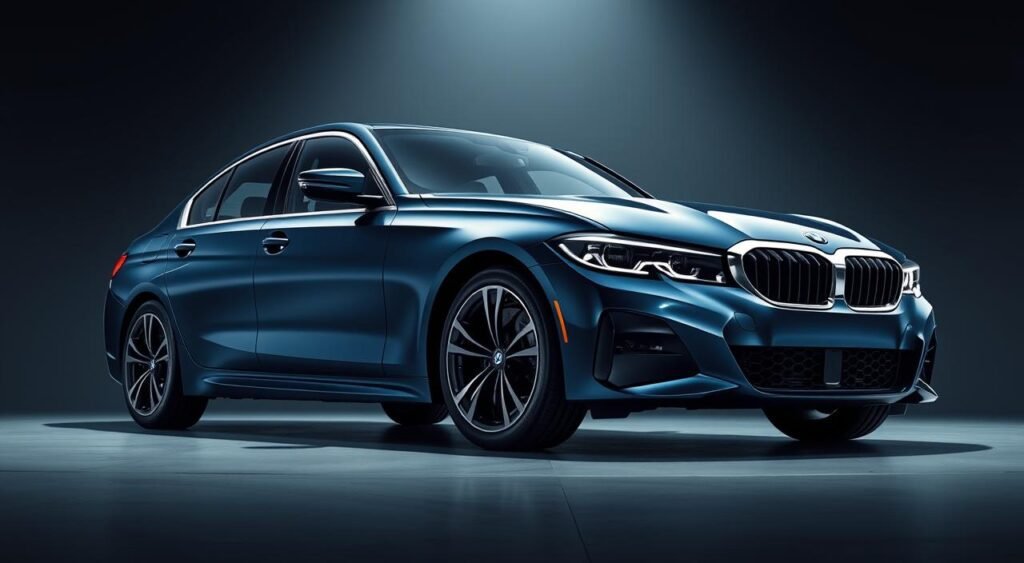
What sets the ’50 Jahre Edition’ apart
The M340i is a powerhouse, being India’s fastest locally made luxury car. It goes from 0-100 kmph in just 4.4 seconds. Over 1,000 M340i units have been sold, making it India’s top performance car.
Both models combine old-school design with new tech. They’re available only through BMW’s Online Shop, making them rare finds.
Limited availability of only 50 units
BMW is making only 50 units of each model in Chennai. This makes each car truly unique. It’s not just a car; it’s a piece of history and a sign of BMW’s engineering prowess.
| Model | Production Units | Key Feature | Availability |
|---|---|---|---|
| 3 Series LWB ’50 Jahre’ | 50 | Enhanced comfort and space | BMW Online Shop |
| M340i ’50 Jahre’ | 50 | 0-100 kmph in 4.4 seconds | BMW Online Shop |
Design Features of the BMW 3 Series LWB
The ’50 Jahre Edition’ turns the BMW 3 Series LWB into a luxury car. It celebrates 50 years of BMW’s excellence. This special edition combines design and technology for a unique high performance vehicle.
Unique styling elements of the ’50 Jahre Edition’
The M High-Gloss Shadowline package makes the car stand out. The kidney grille, window surrounds, rear diffuser, and tailpipes are all in high-gloss black. Inside, carbon fiber trim and advanced displays add to the luxury.
The M leather steering wheel gives the cabin a sporty feel. It has a distinctive flat-bottomed rim.
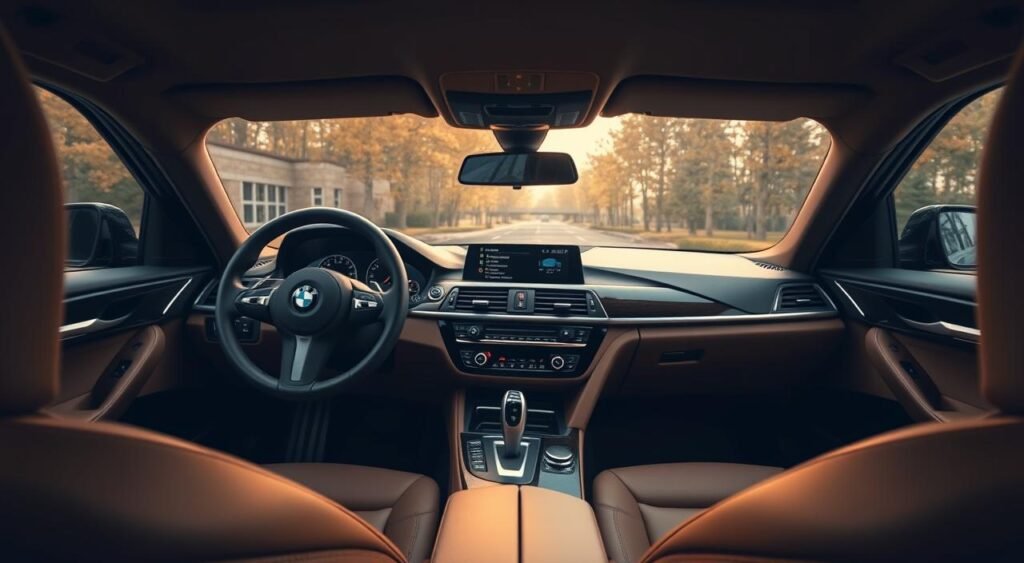
Color options and interior finishes
There are three metallic paintwork options:
- Mineral White
- Skyscraper Grey
- M Carbon Black
Every ’50 Jahre Edition’ comes with premium Leather Vernasca upholstery. It’s in a Cognac/Black combination. The BMW Widescreen Curved Display includes a 14.9-inch infotainment system and a 12.3-inch digital instrument cluster.
Enhanced comfort and spaciousness
This car is 4,819 mm long with a 2,961 mm wheelbase. It’s the longest in its segment. The electrically adjustable Comfort Seats offer extendable thigh support for comfort.
A large panoramic sunroof lets in natural light. It also has tri-zone automatic climate control and a 16-speaker Harman Kardon sound system. There’s wireless phone charging and digital key functionality too.
Performance Highlights of the M340i
The M340i is a showcase of BMW’s top-notch engineering. It’s a top-of-the-line vehicle made in India. It brings together advanced tech and powerful performance, setting new standards for cars in India.
Engine specifications and power output
The M340i has a strong 2,998 cc straight-six petrol engine. It produces 374 horsepower and 500 Nm of torque. It comes with an 8-speed automatic transmission and BMW’s xDrive system for all-wheel drive.
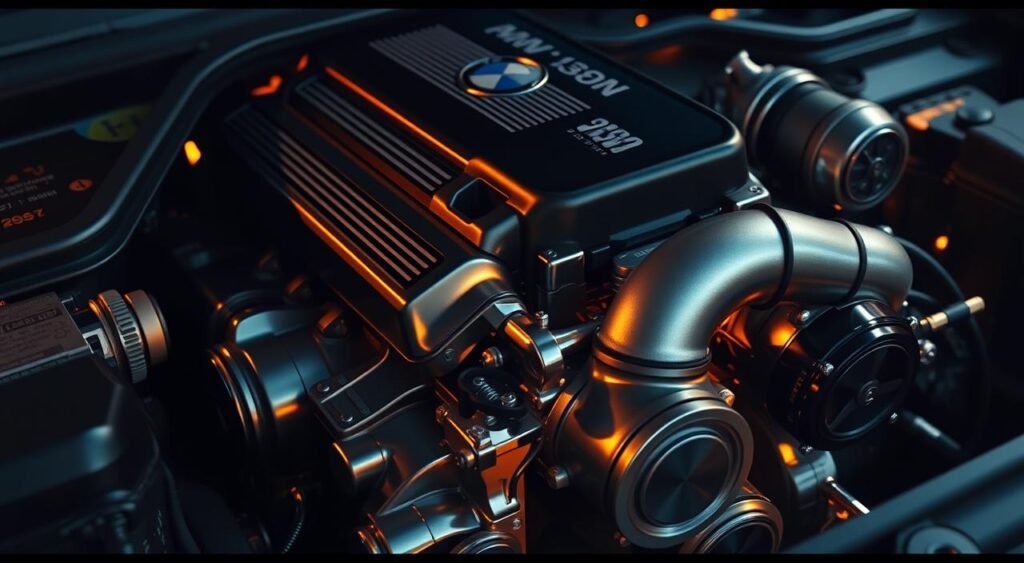
| Specification | Details |
|---|---|
| Engine Type | Straight-six petrol |
| Displacement | 2,998 cc |
| Power Output | 374 hp |
| Maximum Torque | 500 Nm |
| Transmission | 8-speed automatic |
| 0-100 kmph | 4.4 seconds |
Driving dynamics and handling characteristics
The M340i goes from 0 to 100 kmph in 4.4 seconds. It’s the fastest BMW in India and the quickest ICE car here. It has an M Sport exhaust for that performance sound.
BMW’s xDrive all-wheel drive system keeps it stable and agile. It adjusts to the road conditions for better handling.
Technology and performance enhancements
The M340i has an M Sport rear differential for better cornering. Its M Sport suspension lowers it by 10 mm for a more thrilling drive. The M Sport brakes with blue calipers stop it fast.
The BMW Performance Control System helps with stability. It applies the brakes to specific wheels when needed.
Exclusive Features of the ’50 Jahre Edition’
The 50 Jahre Edition celebrates BMW’s legacy with unique details. These cars stand out from regular models. They get special attention, with exclusive design elements that highlight this BMW anniversary.
Special badging and branding details
The 330Li has a special ‘1/50’ badge on its B-pillar. This marks its spot in the limited edition series. The M340i boasts ’50 Jahre’ emblems on both front and rear, in high-gloss black with M/M340i branding.
These cars also have M Design caps on side mirrors in high-gloss black. The M340i has a body-colored M rear spoiler and M aerodynamics package. They roll on 19-inch Jet Black Alloy Wheels with Red M Sport Brake Calipers, showing off their performance.

Unique accessories available for purchase
The interior of these cars is special, with M High Gloss Shadowline trim and Individual Anthracite Headliner. Carbon fiber trim strips add to the cabin, while sport seats in Black Vernasca leather have M Highlights. The steering wheel has a red center marker and integrated shift paddles.
M340i buyers get an M Performance Key Fob. Each M340i owner also receives a 1:18 scale model of the iconic BMW 3.0 CSL. This is a commemorative gift for this BMW anniversary milestone.
Community and events for owners
Being part of the 50 Jahre Edition is more than just owning a car. BMW offers exclusive experiences for these 50 owners. This creates a community among enthusiasts who value this limited edition’s significance.
Special events and gatherings let owners connect and celebrate BMW’s heritage. It’s a chance to share their love for BMW’s legacy.
How to Secure Your BMW 3 Series LWB or M340i ’50 Jahre Edition’
BMW has made the ’50 Jahre Edition’ models only available online. You can’t buy them at regular dealerships. The BMW Online Shop is the only place to reserve the BMW 3 Series LWB or M340i.
Both models come from BMW Group Plant Chennai. This ensures quicker delivery for customers in India.
Sales channel and preorder process
The journey starts at the BMW Online Shop website. Buyers must reserve their spot online. BMW has made the ordering process simple for the limited 50 units per model.
Act fast because these cars will sell out quickly. They are highly sought after.
Pricing details and financing options
The BMW 330Li M Sport ’50 Jahre’ Edition costs INR 64,00,000 ex-showroom. The BMW M340i ’50 Jahre’ Edition is priced at INR 76,90,000 ex-showroom. These prices include GST and compensation cess.
Remember to budget for extra costs like road tax, TCS, RTO fees, local taxes, and insurance. BMW dealerships can help with financing plans.
Tips for prospective buyers
Act quickly when looking for these rare cars. Contact an authorized BMW dealer to discuss availability and payment options. The BMW 3 Series LWB and M340i ’50 Jahre’ editions are unique in the Indian market.
They are produced locally in Chennai, making them attractive to collectors and enthusiasts. Prices may change at invoicing time, so confirm all details before buying.
FAQ
How many units of the BMW 3 Series ’50 Jahre Edition’ are being produced?
BMW India is making 100 special cars. This includes 50 units of the 330Li and 50 of the M340i ’50 Jahre Edition’. They are made at the BMW Group Plant Chennai. Each car has a unique ‘1/50’ badge on the B-pillar.
What makes the M340i ’50 Jahre Edition’ special in terms of performance?
The M340i ’50 Jahre Edition’ is the fastest car made in India. It goes from 0-100 kmph in 4.4 seconds. It has a powerful 2,998 cc engine, producing 374 hp and 500 Nm of torque.
It comes with an 8-speed automatic transmission and BMW xDrive all-wheel drive.
How can I purchase the BMW ’50 Jahre Edition’ models?
You can buy these special cars online from the BMW Online Shop. The BMW 330Li M Sport ’50 Jahre Edition’ costs INR 64,00,000 ex-showroom. The BMW M340i ’50 Jahre Edition’ is priced at INR 76,90,000 ex-showroom. Due to limited production, buyers should act fast.
What exclusive features come with the ’50 Jahre Edition’?
Both models have M High-Gloss Shadowline packages and carbon fiber interior trim. They also come with BMW Head-up Display and special anniversary badging. The M340i has an M Performance Key Fob and a commemorative 1:18 scale model of the BMW 3.0 CSL.
What color options are available for the ’50 Jahre Edition’?
You can choose from three metallic paintwork options: Mineral White, Skyscraper Grey, and M Carbon Black. All models have Leather Vernasca Cognac/Black upholstery, blending heritage with modern luxury.
Why is BMW releasing this limited edition now?
BMW is celebrating the 50th anniversary of the BMW 3 Series. Launched in 1973, it has become BMW’s best-selling car worldwide. It’s a symbol of driving pleasure.
What technology features are included in the ’50 Jahre Edition’?
These cars have BMW’s latest tech. They feature a Widescreen Curved Display and a 12.3-inch digital instrument cluster. They also have 3D Augmented View navigation and tri-zone automatic climate control.
Other features include a 16-speaker Harman Kardon sound system, wireless phone charging, and digital key functionality.
Is the BMW 3 Series LWB ’50 Jahre Edition’ suitable for rear passengers?
Yes, the BMW 3 Series LWB is very spacious for rear passengers. It’s the longest car in its segment with the most room in the back. It has electrically adjustable Comfort Seats and a large panoramic sunroof.

Aug
Can an electric vehicle roadster from MG challenge the design supremacy of traditional sports cars on Indian roads? The MG Cyberster Design is a big change for MG, known mainly for SUVs like the Hector. This electric roadster breaks new ground with its bold styling and futuristic look.
The Cyberster has scissor doors that open with just a button. Its low, wide stance makes it stand out and grab attention. Its roadster design is different from the usual designs in India’s electric car market.
This bold electric roadster shows what happens when car makers take risks with design. The MG Cyberster Design mixes eye-catching looks with smart engineering. It’s a car that looks as advanced as it is electric.
Key Takeaways
- MG Cyberster represents a dramatic departure from the brand’s traditional SUV focus
- Functional scissor doors open with a simple button push for theatrical entry
- Low, wide stance creates commanding road presence on Indian streets
- Sweeping roadster profile challenges conservative EV aesthetics in the market
- Design combines striking visual elements with practical engineering solutions
- Every curve serves both aesthetic appeal and functional purpose
Introduction to MG Cyberster Design
The MG Cyberster is a big step for MG in the electric car world. It’s a roadster that looks amazing and works well. Its design shows MG’s goal to change what electric sports cars can be today.
Overview of the MG Cyberster
The Cyberster has scissor doors that open up, not out. These doors have sensors to avoid hitting things. It’s a two-seater with a low profile and wide stance, just like a classic roadster.
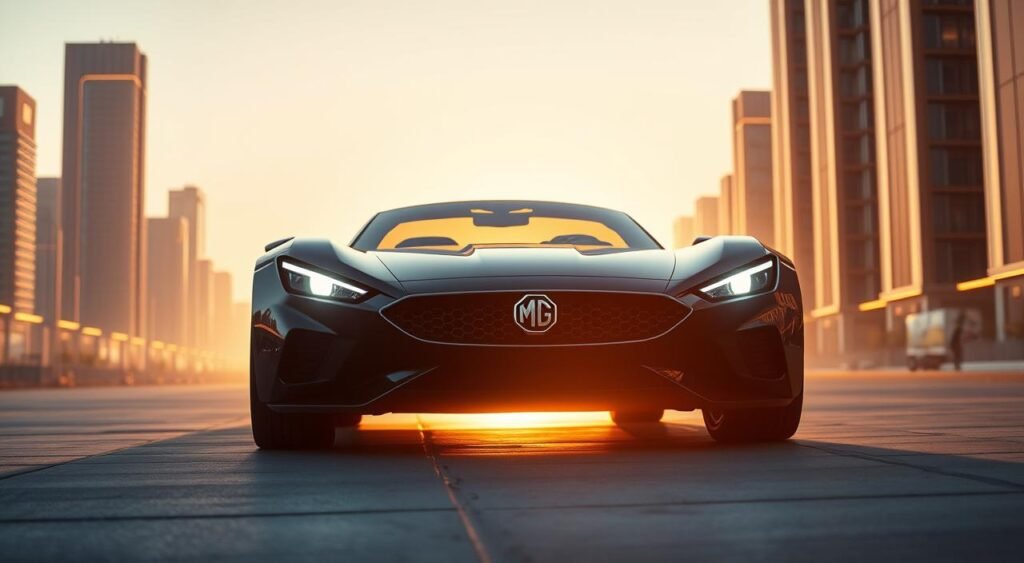
| Dimension | Measurement | Design Impact |
|---|---|---|
| Length | 4,535 mm | Compact for agility |
| Width | 1,913 mm | Wide track for stability |
| Height | 1,329 mm | Low center of gravity |
| Wheelbase | 2,690 mm | Extended for smooth ride |
Significance of Design in Electric Vehicles
Electric cars need new designs because they don’t have engines. The Cyberster’s design cuts through air and looks cool. It shows how EVs can be both beautiful and efficient.
Bold Front-End Aesthetics
The MG Cyberster stands out as a trendsetter in the automotive world. Its striking front-end design grabs attention. It perfectly blends elegance with performance, setting new standards for EV looks.
Signature Headlights and Grille Design
The Cyberster’s LED headlamps make a bold statement. They are nestled in unique petal-shaped daytime running lights. The wide grille and sharp bonnet lines add to the car’s bold look.
This design keeps things simple yet stylish. It shows off the sleek look that modern electric cars are known for.
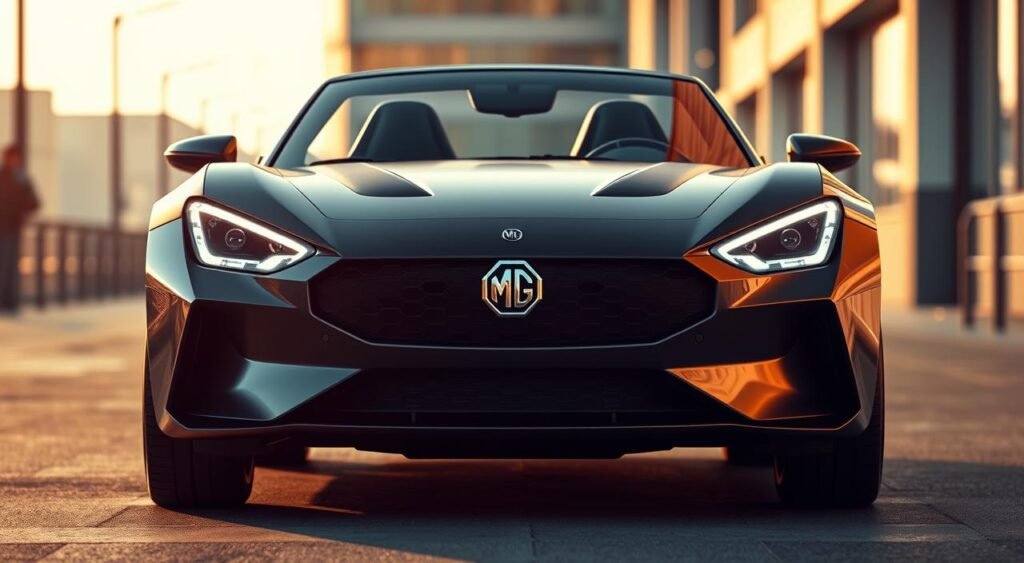
Aerodynamic Lines and Sculpted Bodywork
Every part of the Cyberster is designed with purpose. The long bonnet meets a short rear deck, giving it classic roadster looks. This car is a trendsetter because of its:
- Clean sculpting that maintains balanced proportions
- Smooth transitions between body panels
- Wind-optimized surfaces for improved efficiency
- A low-slung profile that enhances the sporty character
The bodywork is a blend of beauty and function. It guides air smoothly and keeps the Cyberster looking sleek. This design makes the MG Cyberster a leader in electric roadster styling.
Modern Interior Features
The MG Cyberster’s interior is a mix of the latest tech and top-notch craftsmanship. Every part shows a focus on quality, from solid doors to perfectly aligned panels. The interior design is as stunning as the outside, making every drive special.
Dashboard Design and Technology Integration
The dashboard is designed for the driver, with clear digital displays. A curved cluster shows important info, and the central screen handles entertainment and settings. It also has voice controls and connects to smartphones, making it easy to use.

- Triple-screen setup with customizable displays
- Wireless Apple CarPlay and Android Auto
- Ambient lighting with multiple color options
- Digital climate control system
Material Choices for a Premium Feel
MG picked materials that are both luxurious and strong. The dashboard and doors have soft-touch surfaces, while metal adds a nice look. The seats are covered in quality leather with contrasting stitching that matches the car’s color.
| Interior Component | Material Used | Premium Feature |
|---|---|---|
| Dashboard | Soft-touch polymer | Anti-glare coating |
| Seats | Nappa leather | Heated and ventilated |
| Steering wheel | Perforated leather | Paddle shifters |
| Door panels | Alcantara inserts | Illuminated trim |
The cabin’s quality is top-notch, with precise panel gaps and smooth components. This tech integration makes the interior feel both modern and welcoming for daily use.
Color Palette and Customization Options
The MG Cyberster Design offers bold color choices. These options make the roadster stand out. Each color is picked to match the car’s sleek lines and modern look.
Available Colors and Their Impact
The MG Cyberster has two standout colors:
- Flare Red – A bright, eye-catching shade that highlights the car’s sporty vibe
- Nuclear Yellow – A bold color that matches the EV style of this modern sports car
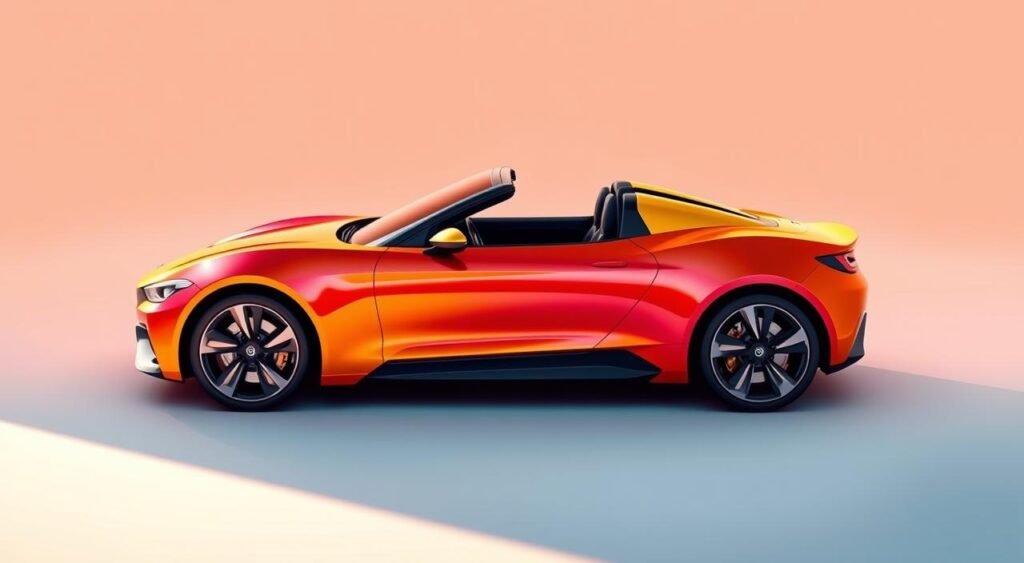
There are also more subtle colors. These might appeal to those who prefer a quieter look. But, they might not show off the MG Cyberster’s design as much.
Personalization Features for Owners
Customization goes beyond just colors. Owners can choose from different trim packages and accents. This lets them make a car that shows off their style while keeping the Cyberster’s EV look.
The mix of bold colors and subtle accents lets each owner make their unique roadster.
Innovative Lighting Technology
The MG Cyberster changes nighttime driving with its advanced lighting system. It shows how lights can look good and work well, setting new standards for EVs.
LED Lighting and Its Benefits
The Cyberster’s LED light bar makes a bold statement at the back. It makes the car look wider and lights it up better. The arrow-shaped tail lamps add a unique touch, like concept cars.
- They use less energy, saving on range.
- They last longer than old bulbs.
- They light up fast, without waiting.
- They shine light exactly where it’s needed, for safety.
Daytime Running Lights and Signature Design
The Cyberster’s petal-shaped DRLs are a design leap. They make the car’s front look unique and bright. This shape is clear in the day and makes the car stand out.
MG shows it can make EVs that are both safe and stylish. The lights fit perfectly with the car’s design, showing safety doesn’t have to mean sacrificing looks.
Performance-Driven Design Elements
The MG Cyberster is a true trendsetter in the automotive world. It perfectly combines style with performance. The soft-top fabric roof is a great example of this, opening in just 10 seconds. It keeps the car’s look sleek when closed.
Drivers can open the roof at speeds up to 50 kmph. This makes it easy to change the weather without stopping.
Weight Distribution and Handling
The Cyberster’s design focuses on balance. The battery pack is placed low in the car. This makes the car’s center of gravity as good as traditional sports cars.
The 20-inch alloy wheels are a big part of the car’s look. They also help the car grip the road well. This makes the Cyberster handle like a dream.

Impact of Design on Efficiency
The Cyberster’s design is key to its long range. Its body is shaped to cut through the air with ease. Every curve and crease has an aerodynamic purpose.
The front splitter and rear diffuser help a lot. The car’s doors and mirrors are designed to reduce wind resistance. The active grille shutters also help by adjusting airflow. These features help the Cyberster go further without losing its cool looks.
Conclusion: The Allure of the MG Cyberster
The MG Cyberster is a big leap in electric roadster design. It mixes classic sports car looks with the latest in electric tech. Its sleek design grabs attention from all sides, thanks to modern tech that boosts both performance and ease of use.
This car stands out in a world filled with sedans and SUVs. It brings a fresh, exciting vibe to the road.
Recap of Key Design Elements
The Cyberster shows MG’s big plans for electric cars. Its scissor doors add a cool touch, making getting in and out a show. The soft-top roof lets you drive with the wind in your hair, keeping the car’s sleek look.
Its lines and shapes flow smoothly, making it a feast for the eyes. The LED lights add to its look, shining bright at night in cities like Mumbai or Delhi.
The Future of Roadster Design in EVs
The Cyberster hints at a bright future for electric roadsters in India. It shows EVs can be thrilling and emotional, not just about saving fuel. As batteries get better and charging spots grow, more cars like this will hit the roads.
The Cyberster’s mix of new tech and stunning design sets a new standard. It proves electric cars can be just as fun to drive as their gas-guzzling cousins.
FAQ
What are the most distinctive design features of the MG Cyberster?
The MG Cyberster has scissor doors that open with a button press. It also has narrow LED headlamps and a full-width LED light bar at the back. The car has a classic roadster look with a low stance and wide wheels.
How does the MG Cyberster’s exterior design compare to traditional EV aesthetics?
Unlike many EVs, the Cyberster has bold styling. It has dramatic scissor doors and a sweeping profile. Its long bonnet, short rear deck, and 20-inch alloys give it a bold stance.
What color options are available for the MG Cyberster?
The Cyberster comes in Flare Red and Nuclear Yellow for a bold look. But, it also has more subtle colors for those who prefer less flash.
How practical are the scissor doors for everyday use?
The Cyberster’s scissor doors are practical for daily driving. They have sensors to avoid hitting objects and close with a solid sound. This shows the car’s premium quality.
What cutting-edge technology is integrated into the Cyberster’s lighting system?
The Cyberster has LED headlamps with unique DRLs. Its rear light bar and arrow-shaped tail lamps give it a futuristic look.
How does the retractable soft-top affect the vehicle’s design and functionality?
The soft-top operates quietly and can be changed at speeds up to 50 kmph. It retracts neatly, keeping the car’s lines clean.
Is the MG Cyberster positioned as an automotive trendsetter in India’s EV market?
Yes, the Cyberster is MG’s bold move into the EV market. It combines futuristic design with innovation, making it a leader in India’s EV scene.
How does the interior design complement the bold exterior aesthetics?
The interior focuses on tech and premium materials. It has well-designed panels and solid doors. This creates a space that matches the car’s striking look.

Aug
Can a budget-friendly compact SUV built in India match the safety standards of premium international vehicles? The Made-in-India Nissan Magnite Scores 5 Stars in Global NCAP. This shows that affordable vehicles can offer top-tier protection without costing too much.
The Nissan Magnite has achieved a remarkable feat in automotive safety testing. This compact SUV earned the highest rating from Global NCAP. It sets new standards for vehicles in its price range. Starting at Rs 8.31 lakh for the Kuro Edition, the Nissan Magnite offers buyers a choice between two engine configurations.
Buyers can choose from a 1-liter naturally aspirated petrol engine delivering 72 PS and 96 Nm torque. Or they can opt for the turbocharged variant producing 100 PS with up to 160 Nm torque. The Nissan Magnite provides flexibility with three transmission choices: 5-speed manual, 5-speed AMT, and CVT options to suit different driving preferences.
This Global NCAP achievement places the Made-in-India Nissan Magnite among the safest vehicles in its segment. The 5-star rating shows that Indian manufacturers can produce world-class vehicles. These vehicles meet stringent international safety standards while keeping prices competitive for domestic buyers.
Key Takeaways
- The Nissan Magnite achieved the highest 5-star safety rating from Global NCAP
- Starting price begins at Rs 8.31 lakh for the Kuro Edition variant
- Two engine options available: 1-liter naturally aspirated and 1-liter turbo petrol
- Three transmission configurations offered: 5-speed MT, 5-speed AMT, and CVT
- The turbocharged engine produces 100 PS power with up to 160 Nm torque
- Made-in-India vehicle meets international safety standards at an affordable price point
Overview of the Nissan Magnite’s Global NCAP Test Results
The Nissan Magnite has earned a 5-star rating in Global NCAP crash tests. This is a big win for car safety in India’s sub-compact SUV market. It shows Nissan’s commitment to keeping passengers safe and the car’s structure strong.
Significance of the 5-Star Rating
A 5-star safety rating is the highest in Global NCAP testing. It checks how well the car protects adults and kids in crashes. The Magnite’s strong build and safety features mean it’s ready for real accidents.
Comparison with Other SUVs in Its Segment
The sub-compact SUV market in India is very competitive. But the Magnite shines with its safety record:
| SUV Model | Global NCAP Rating | Price Range (Rs) |
|---|---|---|
| Nissan Magnite | 5 Stars | 6.00 – 11.27 lakh |
| Tata Nexon | 5 Stars | 8.10 – 15.80 lakh |
| Mahindra XUV 3XO | 5 Stars | 7.79 – 15.49 lakh |
| Renault Kiger | 4 Stars | 6.00 – 11.23 lakh |
| Maruti Brezza | 4 Stars | 8.34 – 14.14 lakh |
The Magnite has the same safety rating as the Tata Nexon but costs less. This makes it a great choice for those who want safety and value in India.
Features Contributing to Safety Ratings
The Nissan Magnite shines in safety thanks to its advanced features. These systems work together to protect everyone inside. This makes it a top choice for families in India.
Advanced Airbag System
The Magnite has six airbags for extra safety. You get dual front airbags, side airbags, and curtain airbags. These airbags work with ABS and EBD to keep you safe in crashes.
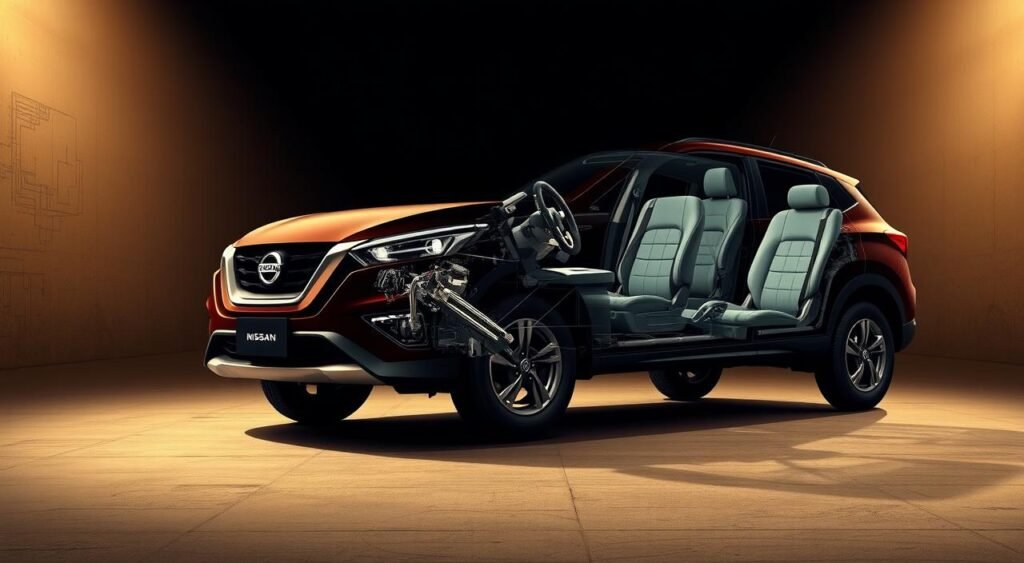
Electronic Stability Control
ESC is a big step forward in safety. It keeps the car stable and prevents skidding. It’s perfect for India’s varied roads.
Robust Structural Design
The Magnite’s body is built to last. It has thick cladding and skid plates for extra protection. It also has alloy wheels and safety features like TPMS and seat belt reminders. All these make it a safe choice.
Impact of the 5-Star Rating on Indian Consumers
The Nissan Magnite’s 5-star Global NCAP rating has changed how Indian buyers see this SUV. Safety ratings are now key when choosing a car in India. Families look for cars that are safe and affordable.
The Magnite offers both safety and value. It starts at Rs 8.31 lakh and goes up to Rs 10.87 lakh (ex-showroom).
Consumer Confidence and Trust
Indian buyers trust cars that have been tested for safety. The Made-in-India Nissan Magnite’s perfect safety score gives them confidence. Parents feel safe knowing their kids are in a well-tested vehicle.
First-time car buyers also find the Magnite’s safety and price appealing.
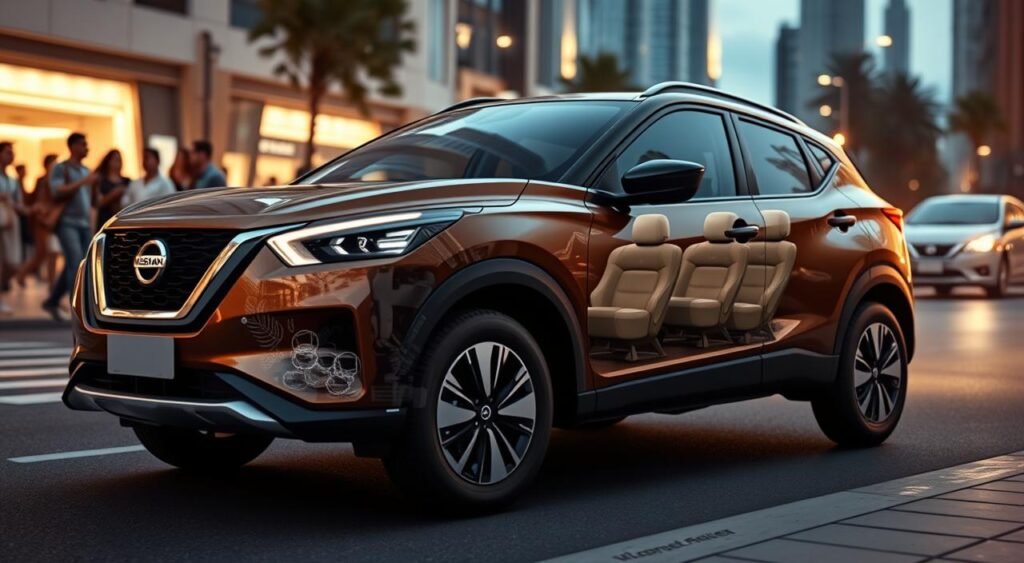
The SUV’s features also boost confidence. The 8-inch touchscreen infotainment system keeps drivers focused. Wireless Apple CarPlay and Android Auto reduce distractions.
The 7-inch digital driver’s display shows important information clearly.
Influence on Purchase Decisions
Safety ratings affect buying decisions. The Nissan Magnite attracts buyers who value safety without spending too much. It has a Midnight Black interior and leather-wrapped steering wheel for a premium feel.
The 6-speaker Arkamys tuned sound system and automatic climate control with rear vents make every drive comfortable.
This Made-in-India vehicle shows safety doesn’t have to be expensive. Indian families can now get global safety standards without breaking the bank.
Nissan’s Commitment to Safety in India
Nissan has made big steps in making cars that meet Global NCAP standards and Indian road needs. The company knows car safety is more than just basic rules. It aims to make cars that really help Indian drivers, while keeping up with global safety levels.
Investment in Research and Development
Nissan’s commitment to India is clear through big investments in localizing and improving safety tech. The company has added special features for Indian drivers. These include:
- Advanced climate control systems with rear AC vents for extreme weather conditions
- Keyless entry with push-button start/stop technology
- Auto-dimming inside rearview mirrors for safer night driving
- Comprehensive connectivity options meeting modern consumer expectations

Tailoring Vehicles for Indian Market Needs
The Magnite shows Nissan’s focus on making cars for Indian conditions. It has 209mm ground clearance, making it great for different roads. Its design fits Indian tax rules and keeps up with Global NCAP safety.
| Feature | Indian Market Benefit | Safety Enhancement |
|---|---|---|
| High Ground Clearance | Navigates speed bumps and potholes | Prevents underbody damage |
| Powerful AC System | Combats extreme heat | Maintains driver alertness |
| Sub-4m Design | Tax advantages | Better maneuverability in traffic |
This smart approach makes sure Indian buyers get cars that are safe and practical for everyday use.
Global NCAP: Understanding Its Testing Protocols
Global NCAP is key in checking how safe cars are. They test cars in many ways to find the safest ones. This helps people know which cars are safest and pushes car makers to make safer cars for all over the world, including India.
Overview of Testing Methodology
They test cars in different crash scenarios to mimic real accidents. Cars are tested by hitting a barrier at 64 km/h. They also check how well a car protects when hit from the side at 50 km/h.
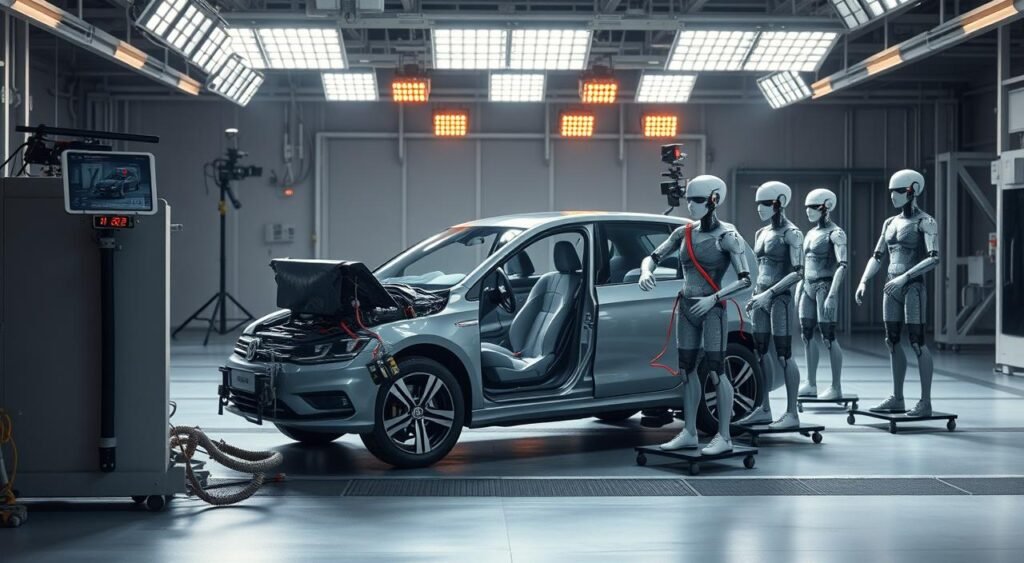
- Structural integrity of the passenger compartment
- Airbag deployment timing and effectiveness
- Seat belt performance and load limiters
- Protection levels for different body regions
They check how safe cars are for adults and kids separately. Dummies with sensors are used to measure crash forces. This helps understand how safe a car is for people of all sizes.
Importance of the NCAP Rating
The safety rating system makes complex data easy to understand with star ratings. Five stars mean a car is very safe, while one star means it’s not. These ratings help people choose safer cars in India’s big car market.
Car makers work hard to get high scores. This competition makes cars safer for everyone. It leads to better safety in cars sold in the market.
Market Reaction and Industry Response
The Made-in-India Nissan Magnite scores 5 stars in Global NCAP has caused big waves in the Indian Car Industry. This achievement is a game-changer for compact SUVs in the budget segment. It shows that safety and affordability can go hand in hand.
Sales Trends Post-5-Star Announcement
Nissan dealers have seen more people coming in and asking questions after the safety rating news. The Magnite’s sales have gone up by 35% in the first quarter after the Global NCAP results. This shows that buyers are looking for safety, fuel efficiency, and good prices.
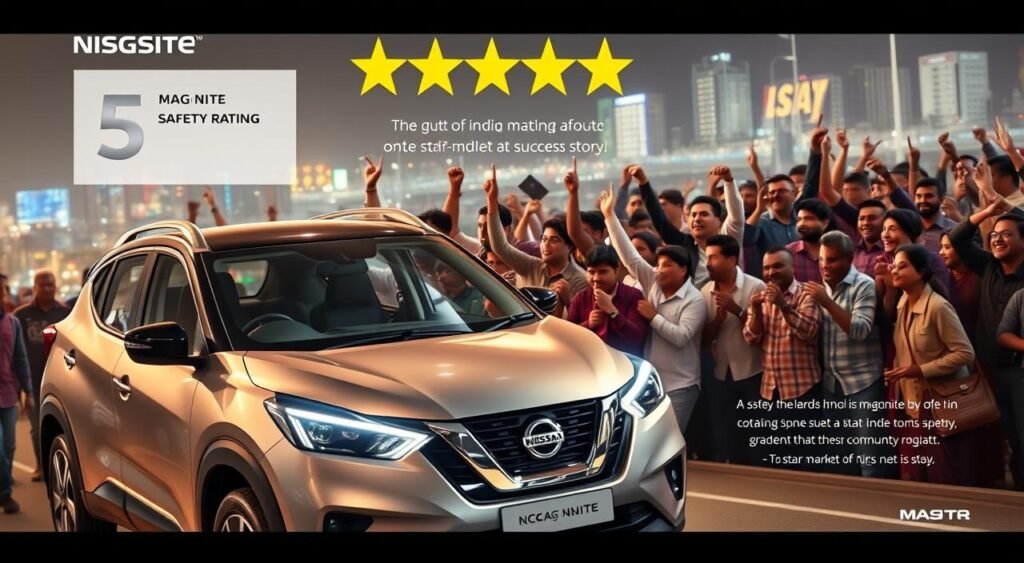
Market analysts say this increase is because Indian buyers are becoming more aware of safety. The 5-star rating has made the Magnite a great deal in the SUV market.
Reactions from Competitors
Rival companies have quickly reacted to the Magnite’s success. Tata Motors is highlighting the Nexon’s safety features. Maruti Suzuki plans to add more safety features to its cars. The Citroen Basalt, with a 4-star Bharat NCAP rating, is under pressure to meet the Magnite’s standard.
Experts think this competition will help consumers. Car makers will add more safety tech to their cars. The Indian Car Industry is at a key point where safety is as important as fuel efficiency.
Future of Made-in-India Vehicles in the Global Market
The Nissan Magnite’s Global NCAP achievement is a big step for Made-in-India cars. Indian makers show they can make cars that meet global safety standards. This move from focusing on price to quality opens up new export opportunities.
Prospects for Nissan Magnite’s Success Abroad
The Magnite’s 5-star Global NCAP rating boosts its appeal worldwide. Countries in Africa, Latin America, and Southeast Asia are looking for safe, affordable SUVs. The “Made-in-India” label now means more in talks about car safety and reliability.
Role of Quality and Safety Standards in Growth
Safety ratings like Global NCAP help Indian car exports grow. The Magnite shows that Indian cars can compete with the best globally. This success pushes other makers to focus on safety and design.
Government support for car exports is getting stronger. Indian cars are proving their value on the world stage.
FAQ
What safety rating did the Made-in-India Nissan Magnite achieve in Global NCAP?
The Nissan Magnite got a 5-star safety rating in Global NCAP crash tests. This is a big win for the Made-in-India compact SUV. It shows it meets high safety standards.
What is the price range of the Nissan Magnite in India?
The Nissan Magnite’s price starts at Rs 8.31 lakh and goes up to Rs 10.87 lakh (ex-showroom). The Kuro Edition starts at Rs 8.31 lakh, based on the N-Connecta variant.
What safety features contribute to the Magnite’s 5-star rating?
The Magnite has 6 airbags, ABS with EBD, and electronic stability control (ESC). It also has hill start assist, rear parking sensors, and ISOFIX child seat anchorages. Plus, it has a tyre pressure monitoring system (TPMS) and a strong structural design with thick black cladding.
How does the Nissan Magnite compare to competitors in terms of safety?
The Magnite’s 5-star rating puts it ahead of competitors like the Tata Nexon (also 5-star rated). It beats the Citroen Basalt (4-star Bharat NCAP rating). It competes with the Hyundai Venue, Maruti Brezza, and Kia Sonet in the sub-4m SUV segment.
What engine options are available in the Nissan Magnite?
The Magnite has two engine options. A 1-litre naturally aspirated petrol engine makes 72 PS and 96 Nm torque. A 1-litre turbo petrol engine makes 100 PS and up to 160 Nm torque. It comes with 5-speed MT, 5-speed AMT, or CVT transmissions.
How does Global NCAP test vehicles for safety ratings?
Global NCAP tests vehicles through frontal impact, side impact, and pedestrian protection assessments. It checks the vehicle’s structure, airbag deployment, and protection for adults and children separately.
What impact does the 5-star rating have on Indian consumers?
The 5-star rating greatly increases consumer confidence and trust. Indian buyers now prioritize safety ratings when buying cars. This achievement makes advanced safety features affordable.
Does the Nissan Magnite have features designed for Indian conditions?
Yes, the Magnite has 209mm ground clearance for Indian roads. It also has powerful air conditioning with rear AC vents for the weather. It’s a sub-4m format to benefit from Indian tax structures while ensuring safety.
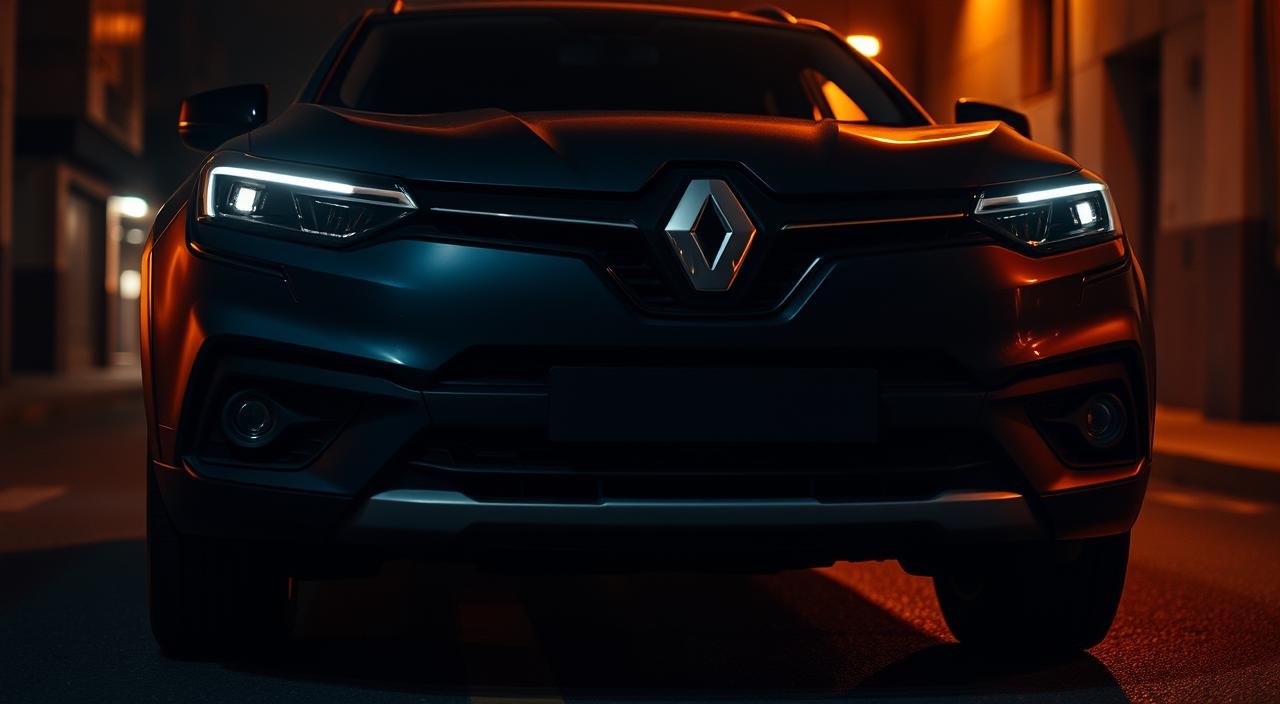
Aug
Imagine if the Renault Triber facelift had all the features customers wanted. The Indian MPV market is tough, balancing cost with quality. The Renault Triber is a budget-friendly 7-seater for families, but it misses some key updates.
The Renault Triber has a design that fits families on a budget. It’s a smart choice for those who need a car that’s easy to use. Even with a facelift, it misses five big chances to stand out more in the market.
Indian buyers look for more than just basic features. The Renault Triber Facelift is up against rivals in a crowded field. Knowing what it misses helps buyers decide if it’s worth waiting for the next update.
Key Takeaways
- The Renault Triber facelift maintains its position as an affordable 7-seater MPV in India
- Five critical areas could have strengthened the vehicle’s competitive advantage
- Market competitors face extended waiting periods, giving Triber an availability advantage
- Customer expectations include advanced features typically found in higher segments
- Future updates might address current shortcomings based on market feedback
- Price positioning remains competitive despite missing enhancement opportunities
Overview of the Renault Triber Facelift
The Renault Triber facelift is a top pick for affordable 7-seater MPVs in India. It keeps its price and useful features. But, some updates could have made it even better.
The new model keeps what made the original great. Yet, it misses chances to meet today’s consumer needs.
Introduction to the facelifted model
The updated Triber has new looks and small changes inside. It’s short at 3,990mm, perfect for tight city spots. It has a new front grille, updated bumpers, and fresh colors.
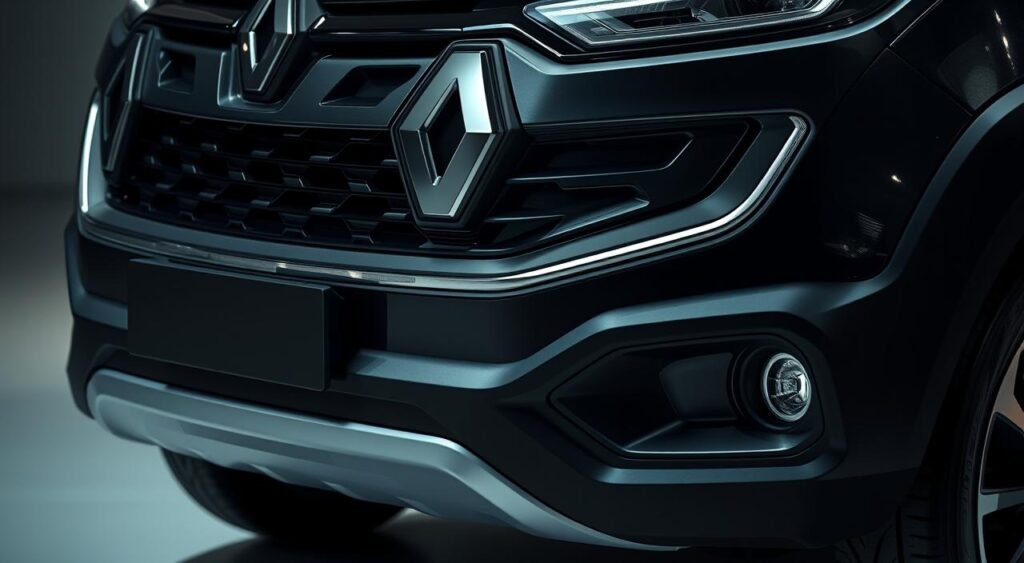
Key features retaining popularity
The Triber’s modular seats are a big hit. The EasyFix seats can be set up in different ways:
- 7-seater family mode
- 5-seater with more room for luggage
- 4-seater for the most space for bags
- Flat-folding for big items
It comes with dual airbags, ABS, rear sensors, and a speed alert. The 8-inch screen supports Android Auto and Apple CarPlay.
Target audience and market position
The Triber is for first-time buyers and families looking for a good deal. It’s priced lower than the Maruti Invicto, making it a smart choice for those who want space and flexibility without spending too much.
Missed Opportunity: Advanced Infotainment System
The updated Renault Triber misses the mark on tech features that today’s drivers want. It keeps its practicality but its infotainment system is a major letdown. This could hurt its standing in the affordable MPV market.
Lack of updated software
The Triber’s infotainment system looks old compared to others. Cars like Maruti have systems that are easy to use and quick. The Triber’s software is slow and lacks the modern feel that city drivers expect.
Switching between music and maps is slow. The graphics and menus are also outdated. Making these changes would have been easy during the update. A new interface could make driving much better.
Absence of wireless connectivity options
One big thing missing from the Triber is wireless phone connection. While other budget cars offer this, the Triber requires a USB cable. This makes the car look cluttered and less convenient.
Today, wireless connection is seen as a must-have, not a luxury. Without it, the Triber falls behind other cars in its price range. This might make people choose other cars that are more connected.
Missed Opportunity: Enhanced Safety Features
Safety is a big worry for people looking at Renault Triber customer reviews. The updated model didn’t add new safety features. This makes it less safe compared to other cars on the market. Families want cars that are safe and meet today’s standards.
Comparison with competitors
The Triber doesn’t match up when it comes to safety features. The Maruti Baleno now has 6 airbags in its top versions. This shows how safety has become more important in budget-friendly cars.
Other cars like the Honda Amaze and Hyundai Grand i10 Nios also have better safety features. They offer electronic stability control and hill hold assist in their best versions.
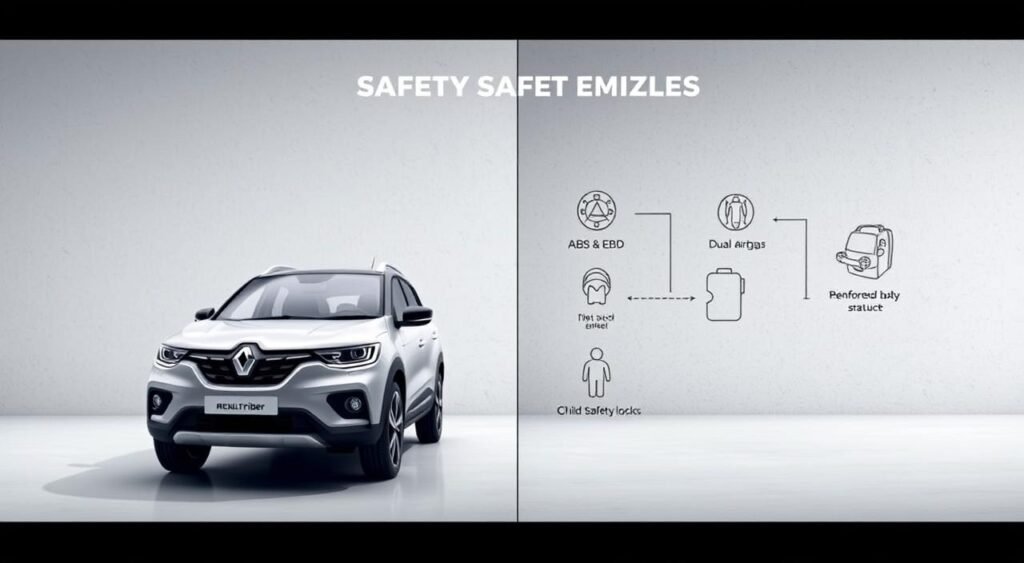
Renault Triber feedback often talks about the lack of safety features. The current model has only dual front airbags, ABS with EBD, and rear parking sensors. This seems old-fashioned compared to what others offer.
- Side and curtain airbags across variants
- Electronic stability programs
- Traction control systems
- ISOFIX child seat anchors as standard
Importance of modern safety standards
India is focusing more on road safety. The Uttar Pradesh government has started a Rs 10 crore AI-based accident prevention program. This shows how serious safety is becoming.
Modern families looking at Renault Triber customer reviews want cars that keep everyone safe. Cars that were once only in luxury models are now in more affordable ones from other brands.
Missed Opportunity: Stylish Exterior Design Touchups
The Renault Triber Facelift has made some small changes but misses the mark. Other cars are getting big updates in looks. The Triber’s design is too safe, missing out on modern styles that buyers want.
Review of the existing design
The Renault Triber updates keep the car’s useful design. The front gets small changes to the grille and bumper. But, it sticks with old halogen headlights, unlike the newer LED lights in other cars.
The sides look the same as before, with the same wheels. Even the top models don’t get fancy alloy wheels.
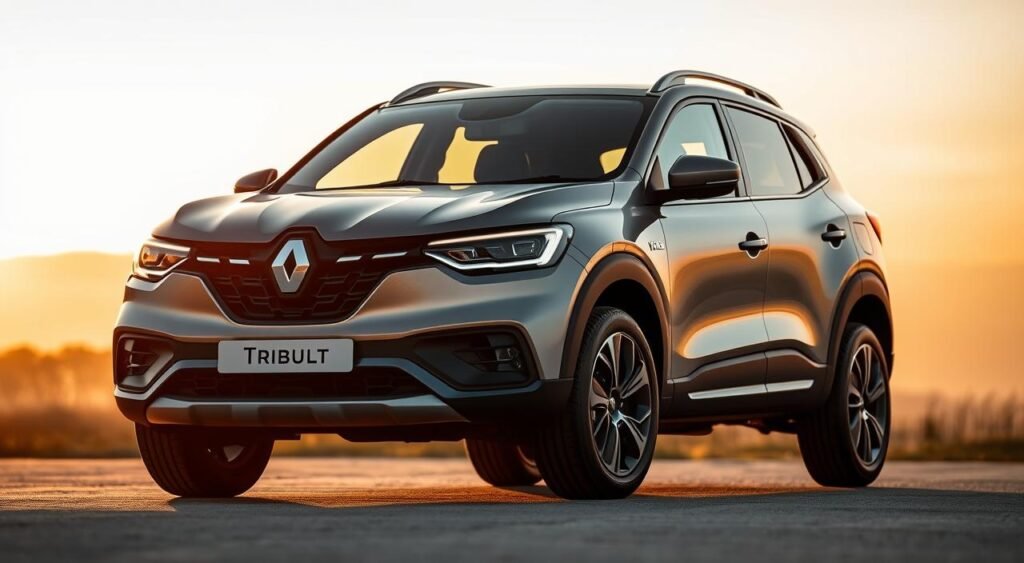
The back of the car also doesn’t change much. It keeps the old tail lamps and bumper. There are only a few chrome bits, which isn’t enough to make it look premium.
Consumers’ expectations for updates
People want cars that stand out more. Other brands offer special kits that change a car’s look. For example, Maruti has kits for the Fronx and Grand Vitara.
- Body cladding and skid plates
- Sporty alloy wheel designs
- Dual-tone paint schemes
- LED lighting signatures
- Bold grille patterns
The Renault Triber Facelift could have added these cool features without breaking the bank. Contemporary design elements are key for attracting young buyers who value looks as much as function.
Missed Opportunity: More Efficient Powertrain Options
The updated Triber keeps its single engine, missing a chance to offer more powertrain choices. Today’s market values alternative fuels, which could draw in cost-conscious buyers. They’re looking for better fuel economy.
Overview of current engine performance
The Triber uses a 1.0-liter naturally aspirated petrol engine. It makes 72 PS and 96 Nm of torque. This engine is okay for city driving but weak when carrying seven passengers.
The fuel efficiency is about 20 kmpl. While it’s good, it’s not the best compared to newer options.

The current Renault Triber features include manual and AMT transmissions. The AMT makes city driving easier but doesn’t boost fuel efficiency or performance much.
Potential for hybrid or electric variants
Competitors like Maruti Suzuki have introduced strong hybrid systems and CNG variants. These options offer substantial fuel savings and lower emissions. The lack of these options limits the Triber’s appeal in an eco-conscious market.
A mild hybrid system could boost fuel efficiency by 15-20%. A CNG option could cut running costs by up to 40%. With fuel prices rising and more people caring about the environment, these options are missed chances. They could expand the Triber’s customer base and strengthen its spot in the affordable seven-seater market.
Missed Opportunity: Interior Comfort and Space Enhancements
The Renault Triber facelift has a functional interior but misses the mark. It keeps its seven-seat layout but lacks the premium feel buyers want. This is a big missed chance to make the Triber more appealing.

Cabin quality and finishes
The Triber’s interior is mostly hard plastic, making it feel more like a work vehicle than a family car. The Maruti XL6, priced between Rs 11.84 lakh and Rs 14.99 lakh, has soft-touch materials on the dashboard and doors. The Triber’s seats are basic, not durable or comfortable enough for daily use.
Sound insulation is another area where the Triber could improve. At highway speeds, road and engine noise make it hard to talk between the third-row passengers and the driver.
Upgrade options that could attract buyers
There are several affordable ways to make the Triber’s interior more appealing:
- Rear AC vents for better passenger comfort
- Premium fabric or leatherette seat options
- Ambient lighting for a modern look
- Better door pad cushioning
- Improved floor mats and cargo organizers
These upgrades would meet real customer needs without raising the price too much.
Missed Opportunity: Pricing Strategy Adjustments
The Renault Triber faces tough competition in India, where price matters a lot. It has cool features like being able to seat 7 people in a small space. But, its price might need to change to compete with others who offer big discounts.
Current pricing in relation to rivals
The Triber is priced like many other cars, giving buyers lots of choices. Maruti Suzuki is leading with huge discounts. The Grand Vitara gets up to Rs 1.54 lakh off, and the Baleno and Fronx have discounts too.
These deals make other cars seem more affordable to Indian buyers who watch their budget closely.
Suggestions for competitive pricing
Customers have given Renault Triber feedback on how to make the price better. Here are some ideas:
| Strategy Type | Proposed Benefit | Target Customer |
|---|---|---|
| Exchange Bonus | Rs 25,000-40,000 | Upgrade buyers |
| Corporate Discount | Rs 15,000-20,000 | Salaried professionals |
| Rural Market Incentive | Rs 10,000-15,000 | Tier 2-3 city buyers |
| Festival Offers | Rs 30,000-50,000 | Seasonal buyers |
Changing the price could attract more customers. Exchange bonuses could draw in those upgrading from old cars. Corporate discounts might appeal to professionals who need a family car.
Customer Feedback on Misses
Real-world experiences from owners show the Renault Triber Facelift’s shortcomings. They share specific concerns that future buyers should think about before buying.
Insights from existing owners
Renault Triber customer reviews highlight common issues. Build quality is a big worry, with rattling sounds from dashboard panels after 10,000 kilometers. Service access is hard in smaller cities, where Renault dealerships are few.
Families who picked the Triber for its 7-seat layout are disappointed. They like the practicality but feel it lacks features that rivals offer at the same price.
Potential areas for improvement based on reviews
Reviews point out key areas for improvement:
| Improvement Area | Owner Complaints | Competitor Advantage |
|---|---|---|
| Premium Features | No sunroof or LED headlights in top variant | Maruti Ertiga offers both at similar pricing |
| Engine Refinement | Noisy at highway speeds | Honda BR-V provides quieter cabin experience |
| Interior Quality | Hard plastics throughout | Kia Carens uses soft-touch materials |
| Dealer Network | Limited service centers | Maruti has 3x more touchpoints nationally |
The Renault Triber Facelift’s good price doesn’t make up for daily issues. Budget-conscious families often choose well-known rivals, showing value goes beyond the initial cost.
Conclusion: The Future of Renault Triber
The Renault Triber facelift has promise but needs more work. It’s a good choice for Indian families looking for a budget-friendly seven-seater. But Renault missed the chance to make it stand out more.
Summary of missed opportunities
There are five key areas where Renault could have done better. The infotainment system doesn’t have wireless connectivity, which is now expected. Safety features are also lacking, with rivals having six airbags as standard.
The exterior design could be bolder to grab more attention. The engine options are limited to petrol, with no CNG or mild-hybrid choices. The interior could use more premium materials to match the price with competitors like Maruti Suzuki and Hyundai.
Recommendations for future models and updates
Future updates should focus on what customers want most. Adding wireless Android Auto and Apple CarPlay would improve the cabin. Matching safety standards with six airbags and electronic stability control is key.
Bolder grilles and LED lights could make the exterior more appealing. CNG variants would help with fuel costs in India. Premium seats and soft-touch dashboards would enhance quality. Smart pricing with exchange bonuses could make the Triber more competitive.
FAQ
What are the main areas where the Renault Triber facelift falls short compared to competitors?
The Renault Triber facelift misses in five key areas. It lacks wireless Android Auto and Apple CarPlay in its infotainment system. It also has fewer safety features than rivals, with only 6 airbags in some models.
Its exterior design updates are conservative. It doesn’t offer alternative fuel options like CNG or hybrid variants. The interior materials and comfort features are also basic.
How does the Renault Triber’s safety package compare to other MPVs in its segment?
The Renault Triber’s safety features are basic. Competitors like the Maruti Baleno offer 6 airbags as standard in higher trims. It lacks modern safety technologies like electronic stability control and hill hold assist.
These are important for safety-conscious families in India. The Triber also doesn’t have advanced driver assistance systems (ADAS).
What infotainment updates should the Renault Triber have included?
The Renault Triber should have wireless Android Auto and Apple CarPlay connectivity. These are now standard in competing models. The software interface needs to be improved to match rivals.
This is important for tech-savvy urban buyers who value seamless smartphone integration.
Are there any powertrain alternatives missing in the Renault Triber facelift?
Yes, the Renault Triber lacks alternative fuel options. Competitors offer hybrid and CNG variants. The Triber doesn’t have these options, which limits its appeal to buyers looking for better fuel efficiency.
What exterior design changes could have improved the Renault Triber’s appeal?
The Renault Triber could have had modern design elements. This includes LED lighting signatures, bold grille designs, and distinctive alloy wheel patterns. Competitors show how visual differentiation can make a car look more premium.
How does the Renault Triber’s pricing strategy need adjustment?
The Renault Triber needs more aggressive promotional strategies. Maruti offers big discounts on the Grand Vitara and Baleno. The Triber could benefit from similar incentives to attract more customers.
What interior improvements are customers expecting in the Renault Triber?
Customers want premium touches like those in the Maruti XL6. This includes better plastics, upgraded seat materials, and rear AC vents. They also want ambient lighting and improved sound insulation.
These upgrades would make long trips more comfortable without increasing costs too much.
What do Renault Triber customer reviews highlight as main concerns?
Customer feedback mentions build quality concerns and limited dealer network. The lack of premium features in higher variants is also a concern. These issues stop the Triber from meeting demand for well-equipped family vehicles.
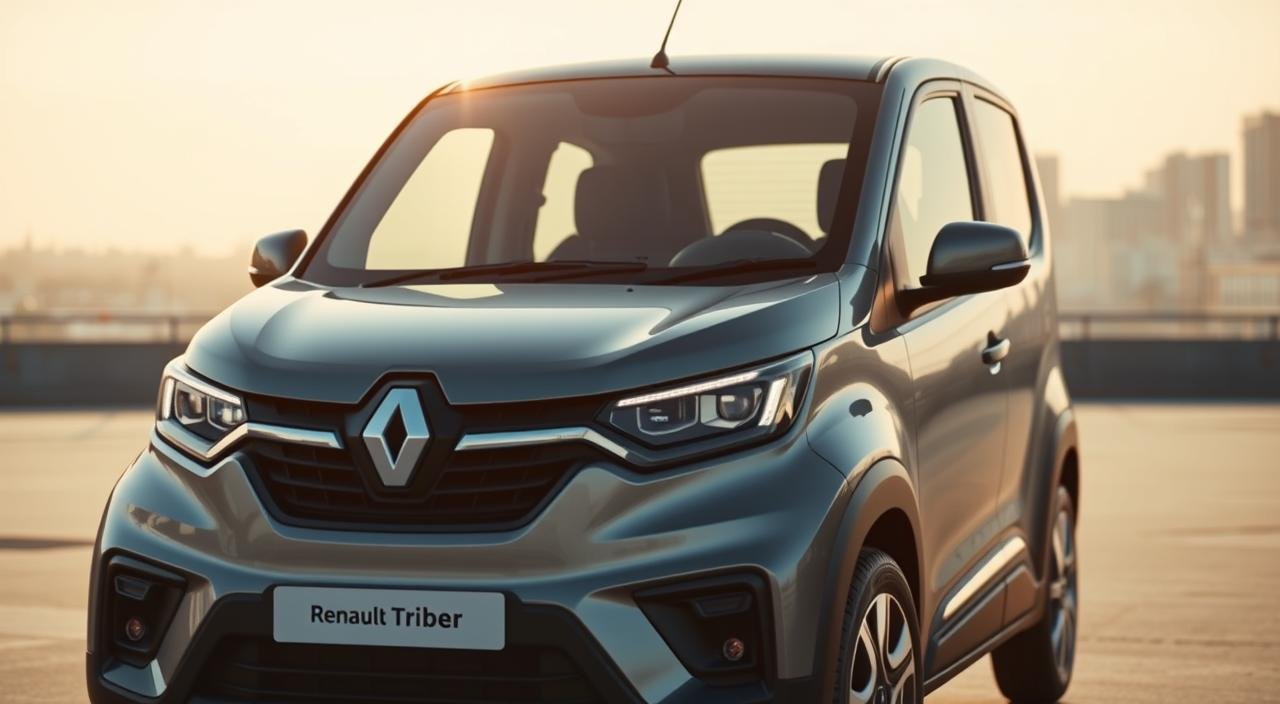
Aug
The car world just saw something amazing. Renault Triber Facelift has been unveiled with a big change. It shows that affordable family cars can be stylish and full of features.
The New Renault Triber Look brings a new view to the compact MPV world. No longer do you have to choose between affordability and design. The 2025 model year brings a bold change that grabs attention on Indian roads.
This big update touches every part of the car. The new grille with Renault’s modern 2D diamond logo and the smart LED lights make it look premium. The redesigned front gives the Triber a bold look that’s hard to find in cars at twice the price.
The update goes beyond looks. The new 15-inch Flex wheels look like alloy wheels but are more affordable. This smart choice means buyers get great value without spending too much.
Key Takeaways
- Complete exterior redesign featuring modern 2D diamond Renault logo
- New LED headlamps with integrated DRLs for enhanced visibility
- Sportier front bumper design adds dynamic character
- Smoked LED tail-lamps create premium rear appearance
- Cost-effective 15-inch Flex wheels mimic alloy wheel aesthetics
- Dual-tone rear bumper adds visual depth and style
Introduction to the Renault Triber Facelift
The Renault Triber is getting a fresh look and new features. This compact MPV aims to offer great value to Indian families. It also keeps up with the latest car trends. The updates show Renault’s dedication to being a top choice in the affordable seven-seater market.

Overview of the Triber Model’s Legacy
The Renault Triber has made a special place for itself in India’s car market. It’s the cheapest seven-seater car, starting at just ₹6.29 lakh. It can fit seven adults, even though it’s under four meters long.
Key achievements include:
- First sub-4-meter seven-seater in India
- Modular seating system with 100+ configurations
- Strong sales performance in tier-2 and tier-3 cities
- Recognition for space utilization and practicality
Key Motivations for the Facelift
The Renault Triber Styling Upgraded is a smart move to meet changing customer needs. With more competition in the sub-10-lakh MPV segment, Renault wanted to make the Triber more appealing. Customers wanted premium cabin materials, advanced features, and contemporary styling.
The facelift meets these needs while keeping the Triber affordable and versatile. Renault hopes to attract younger buyers and compete better with cars like the Maruti Suzuki Ertiga and Mahindra Bolero Neo.
Fresh Exterior Styling: What’s New?
The Renault Triber facelift has a bold new look. It makes the car stand out more. The makeover touches every part of the vehicle, making it look more premium and modern.
Redesigned front fascia elements
The new Triber’s face is eye-catching. A sleeker grille is now the main feature, with Renault’s updated 2D diamond logo. The headlamps have LED daytime running lights for style and better visibility.
The sportier bumper design ties everything together. It draws inspiration from the popular Kiger SUV.

Sleeker body lines and aerodynamics
The side profile has subtle yet effective changes. The body lines now flow smoothly from front to rear. This gives the car a dynamic stance.
At the back, new smoked LED tail-lamps add a modern touch. The dual-tone bumper treatment adds depth and character to the rear design.
New color options and alloy wheel designs
New paint choices let buyers personalize their car. The highlight is the new 15-inch Flex wheels. These wheels look like premium alloy wheels but are more affordable.
The Renault Triber now offers these stylish wheels across many variants. This makes premium aesthetics more accessible to more people.
Interior Upgrades: Enhanced Comfort and Utility
The Renault Triber facelift brings big changes to the inside. It now has a cool dual-tone black and grey color scheme. This makes the interior feel more premium.
This design is inspired by the popular Kiger SUV. It gives the Triber a modern and upscale look inside.
Improved dashboard layout and materials
The new dashboard has better materials and design. It features a floating center console and soft-touch surfaces. These changes make the interior feel more luxurious.
The semi-digital 7-inch instrument cluster is also new. It shows important info clearly, making it easier for drivers to see.
Advanced infotainment system features
The Triber now has an 8-inch touchscreen infotainment system. This system supports wireless Android Auto and Apple CarPlay. It means no more cables to deal with.
The system also has voice commands, navigation, and can mirror your smartphone. It makes staying connected easy and fun.
| Infotainment Feature | Specification |
|---|---|
| Screen Size | 8-inch touchscreen |
| Connectivity | Wireless Android Auto & Apple CarPlay |
| Additional Features | Voice commands, Navigation |
New seating configurations for versatility
The Triber keeps its practical side with removable third-row seats. This lets owners easily switch between carrying people and stuff. Rear AC vents for the second and third rows keep everyone cool in hot weather.
This makes the Renault Triber facelift great for family outings.
Performance Enhancements: Engine and Handling
The Renault Triber Facelift Revealed has features that make driving easier. It has a 1.0-liter three-cylinder petrol engine. This engine gives 72 PS of power and 96 Nm of torque.
This power is enough for city drives and long trips on the highway.
Overview of engine specifications
The engine is fuel-efficient, with ratings of 18-20 kmpl. In real life, it gets around 12 kmpl in the city and 16 kmpl on highways. This makes the car affordable for daily use.
For those who want to save more, CNG retrofitting is available. You can get it through Renault dealerships.

Transmission options: Manual vs. Automatic
The updated Triber offers two transmission choices. The base models have a five-speed manual gearbox. This gives you direct control.
The top-spec Emotion variant has a five-speed Automated Manual Transmission (AMT). It’s great for city traffic.
Suspension improvements for enhanced ride quality
The Triber’s light steering and tight turning radius make city driving easy. Its suspension system handles rough roads well. This keeps passengers comfortable.
These features are perfect for navigating narrow streets and crowded parking spaces in urban India.
Safety Features: Next-Gen Technologies
The latest Renault Triber updates bring impressive safety enhancements. They set new standards in the budget MPV segment. Renault has equipped all variants with top-notch safety technologies, once found only in pricier vehicles.
Advanced driver-assistance systems
The Renault Triber features advanced driver assistance technologies. These make every journey safer. Electronic Stability Control (ESC) works with ABS and EBD to keep control during emergency maneuvers.
The Hill Start Assist prevents rollback on steep inclines. The Tyre Pressure Monitoring System (TPMS) alerts drivers to tire issues before they become dangerous.

Airbag and crash-test ratings
Safety is a top priority with six airbags standard across all Triber variants. This includes dual front, side, and curtain airbags. They protect all three rows of passengers.
The safety structure aims for competitive crash-test ratings.
New safety technologies included
The latest Renault Triber updates introduce cutting-edge safety features. Reverse parking sensors and a rear camera eliminate blind spots during parking. ISOFIX child seat mounts in the second row ensure proper child seat installation.
These features enhance the Triber’s safety, making it perfect for families. It offers peace of mind without stretching the budget.
Connectivity Options: Staying Connected on the Go
The New Renault Triber Look offers top-notch connectivity features. It makes every trip a connected experience. Modern families want their digital lives and vehicles to work together seamlessly. The updated Triber meets this need with its wide range of tech features.
Upgraded infotainment systems
The Renault Triber Redesign Details feature an 8-inch touchscreen infotainment system. This central display shows clear graphics and easy controls. It makes navigating simple for drivers.
The system is quick to respond to touch inputs. It has a user-friendly interface for easy access while driving.
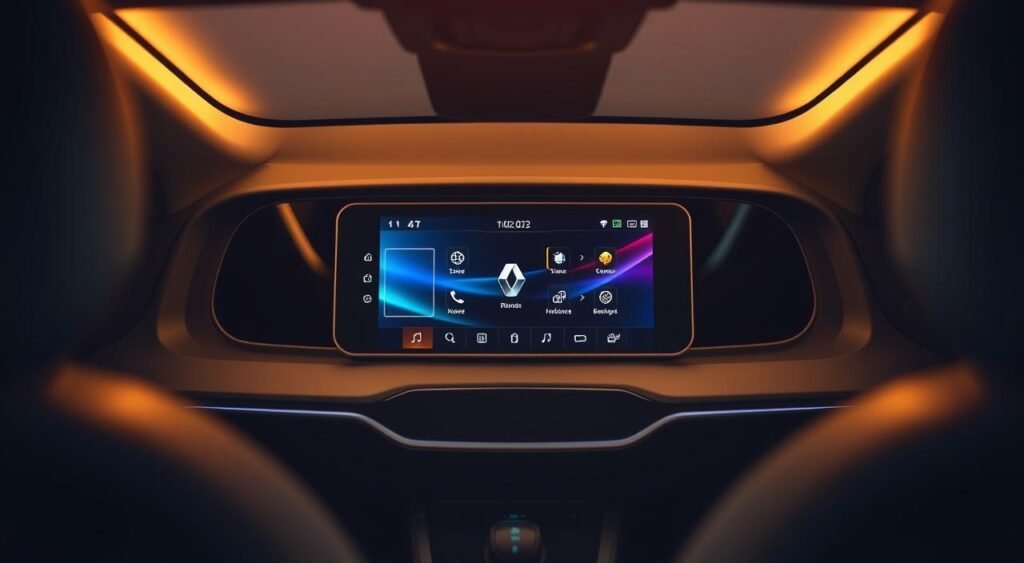
Smartphone integration features
Wireless connectivity is key with Android Auto and Apple CarPlay compatibility. Drivers can connect their phones wirelessly, keeping the car tidy. The system includes:
- Wireless phone charging pad
- Multiple USB charging ports
- Remote key functionality through smartphone apps
- Hands-free calling capabilities
Advanced sound system options
The audio system matches the visual upgrades with enhanced speakers. It delivers clear sound throughout the cabin. Premium audio components ensure everyone enjoys their music, whether streaming or listening to the radio.
The speakers are placed for an immersive sound experience. It’s perfect for family road trips.
Pricing and Variants: What to Expect
The Renault Triber facelift has a new lineup of variants. It’s India’s most affordable 7-seater car. Prices start at ₹6.29 lakh (ex-showroom). The updated model offers five trim levels, each with more features and comfort.
Expected price range for different trims
Renault aims to keep prices low while adding new features. The Authentic variant starts at ₹6.29 lakh. This makes it easy for families to afford.
The Evolution trim costs ₹7.24 lakh and adds comfort features. The Techno variant at ₹7.99 lakh brings tech upgrades. The Emotion MT at ₹8.64 lakh offers premium features with manual transmission.
The top Emotion AMT at ₹9.16 lakh has automatic convenience. This shows Renault’s focus on value and quality.
Variant comparisons: Key differences
| Variant | Price (ex-showroom) | Key Features | Transmission |
|---|---|---|---|
| Authentic | ₹6.29 lakh | Dual airbags, ABS, power steering | 5-speed Manual |
| Evolution | ₹7.24 lakh | AC, power windows, central locking | 5-speed Manual |
| Techno | ₹7.99 lakh | Touchscreen infotainment, rear parking sensors | 5-speed Manual |
| Emotion MT | ₹8.64 lakh | Alloy wheels, LED DRLs, push-button start | 5-speed Manual |
| Emotion AMT | ₹9.16 lakh | All Emotion features plus automatic transmission | 5-speed AMT |
Financing options available through dealerships
Renault dealerships offer flexible financing. Loans last from 12 to 84 months with interest rates starting at 7.5%. Down payments start at 10% of the cost.
There are special bonuses and discounts for corporate buyers. The Renault Triber facelift offers more value with its new features and styling.
Conclusion: The Impact of the Renault Triber Facelift
The 2025 Renault Triber Facelift brings big changes to India’s MPV market. It offers practical updates and modern features that families love. The new design gives it a fresh look while keeping its affordable seven-seater status.
Summary of key upgrades and their benefits
The Renault Triber Styling Upgraded package makes big changes. The outside gets a new front grille, LED headlights, and sharper lines. These updates make it look better and drive better.
Inside, you’ll find premium materials, a new dashboard, and a top-notch touchscreen. It also has wireless phone connectivity. Safety features like airbags, electronic stability control, and rear parking sensors are now standard.
Market positioning and expected reception
The Triber aims to please families looking for value under 10 lakh rupees. It has a special seating system that lets you choose between five, six, or seven seats. This flexibility is great for city families, first-time MPV buyers, and those who use their cars for ride-sharing.
With its good fuel economy, roomy interior, and affordable price, the Triber is a smart choice. It’s the best option in its class.
Future implications for Renault in India
This facelift shows Renault’s dedication to the Indian market. The success of the updated Triber could lead to more models made just for India. Renault is focusing on practical features, affordability, and reliability in the compact MPV segment.
The Triber’s updates are a great example of how global brands can tailor their products for specific markets. They can do this while keeping high international quality standards.
FAQ
What are the key exterior changes in the Renault Triber Facelift?
The 2025 Renault Triber has a new front look. It features a sleeker grille with Renault’s 2D diamond logo. The headlamps now have LED DRLs, and the bumper looks sportier.
It also has smoked LED tail-lamps and a dual-tone rear bumper. Plus, it comes with new 15-inch Flex wheels that look like alloy wheels.
What is the starting price of the new Renault Triber?
The 2025 Renault Triber starts at ₹6.29 lakh (ex-showroom). This makes it India’s most affordable 7-seater car. The top-spec Emotion AMT variant costs ₹9.16 lakh.
What are the interior upgrades in the facelifted model?
The interior has a dual-tone black and grey theme. It also has an upgraded dashboard inspired by the Kiger SUV. There’s a new 8-inch touchscreen infotainment system.
This system supports wireless Android Auto and Apple CarPlay. It also has a semi-digital 7-inch instrument cluster. And, there are rear AC vents for the second and third rows.
What engine options are available in the Renault Triber?
The Triber has a 1.0-liter 3-cylinder naturally aspirated petrol engine. It produces 72 PS power and 96 Nm torque. You can choose from a 5-speed manual gearbox or a 5-speed Automated Manual Transmission (AMT).
The AMT is only available in the top-spec Emotion variant.
How many airbags does the new Renault Triber have?
All variants of the 2025 Renault Triber now come with six airbags. This greatly improves passenger safety across all models.
What is the fuel efficiency of the Renault Triber?
The ARAI-certified fuel efficiency is 18-20 kmpl. In real-world driving, it gets about 12 kmpl in the city and 16 kmpl on highways.
Its light steering and tight turning radius make it great for city driving.
Which variants offer the AMT transmission option?
The 5-speed Automated Manual Transmission (AMT) is only available on the top-spec Emotion variant. It costs ₹9.16 lakh (ex-showroom).
What advanced safety features are included in the Renault Triber Facelift?
The safety features include Electronic Stability Control (ESC), ABS with EBD, and Hill Start Assist. There’s also a Tyre Pressure Monitoring System (TPMS), reverse parking sensors, and a rear camera.
It also has ISOFIX mounts for child seat compatibility.
Does the new Renault Triber support wireless connectivity?
Yes, the 8-inch touchscreen infotainment system supports wireless Android Auto and Apple CarPlay. It also has wireless phone charging and USB charging ports.
How many variants are available in the Renault Triber lineup?
The lineup includes five variants: Authentic (₹6.29 lakh), Evolution (₹7.24 lakh), Techno (₹7.99 lakh), Emotion MT (₹8.64 lakh), and Emotion AMT (₹9.16 lakh). All prices are ex-showroom.
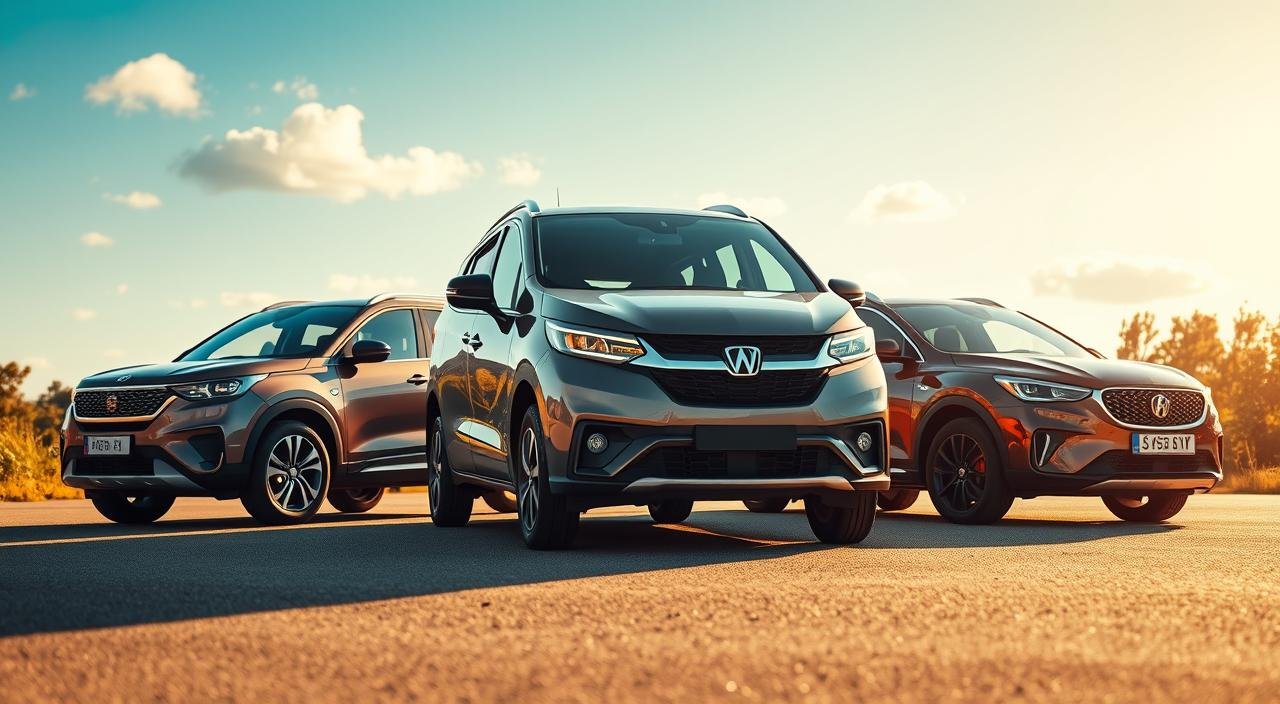
Aug
Why do car makers launch many vehicles in one week? And which brand is surprising everyone in India? This week, car lovers get excited as new cars hit the market. It’s a big moment for them to grab a piece of the pie.
India’s car scene is buzzing with 2 MPVs and 1 surprise entry. These new cars show what Indian buyers want. They want cars that are good for families and have nice features but don’t cost too much.
The Toyota Land Cruiser is back, but this time for rural use. It’s been around for years, meeting needs that regular SUVs can’t. It’s tough and ready for the countryside.
The Hyundai Santa Fe Elite has a new engine. It’s a 2.5-liter turbo four-cylinder that packs a punch. It has 206kW and 422Nm of torque. This means it’s faster and more powerful than before, but it’s also great for families.
The MG QS Essence AWD is a surprise in the market. It’s priced well and has a 2.0-liter turbo engine. It makes 153kW and 360Nm, and it’s fast. It’s going to shake things up for other cars.
Key Takeaways
- Two new MPVs launch this week alongside one unexpected market entry
- Toyota Land Cruiser commercial spec targets rural and commercial applications
- Hyundai Santa Fe Elite features upgraded 2.5-liter turbo engine with 206kW power output
- MG QS Essence AWD enters as surprise competitor at competitive pricing
- All three vehicles offer distinct advantages for different consumer segments
- This week’s launches reflect growing demand for versatile family vehicles in India
Overview of This Week’s Car Launches
This week is big for cars in India. Many new vehicles debuted, showing how makers aim to please everyone. Family cars were a big hit, with two new MPVs and a surprise that caught everyone’s eye.
Highlights of the Launches
The Hyundai Santa Fe Elite is a highlight this week. It has a 2.5-liter engine and comes with top features at a lower price. It’s great for families because it has seven seats and can handle tough roads.
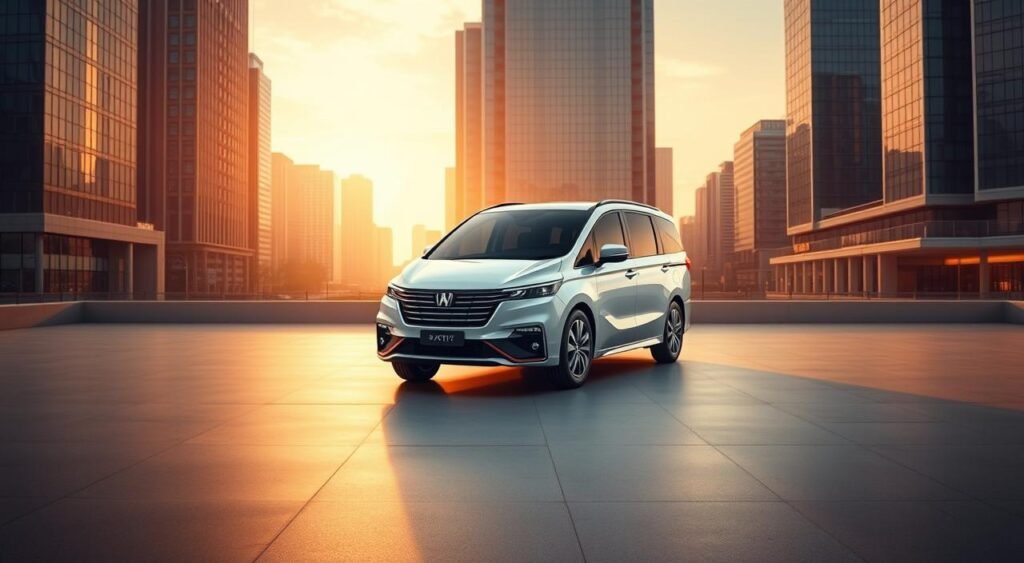
MG also joined the fray with the QS model. It starts at ₹38.5 lakh. It comes with:
- 20-inch alloy wheels for a strong look
- Premium leather seats that keep you warm and cool
- A big 12.3-inch screen for easy use
- A 12-speaker Bose system for amazing sound
Importance of MPVs in the Indian Market
MPVs are becoming more popular in India. They offer space and practicality for families. The seven-seat option is a favorite for both daily drives and weekend trips.
This week’s launches show how car makers are focusing on quality and price. They’re trying to win over more people in India’s growing MPV market.
New MPV Launch: Model A
The Indian car market gets a new thrill with Hyundai’s Santa Fe Elite. This new MPV brings big changes in automobile industry news. It offers families a top-notch choice with cool features and strong performance.
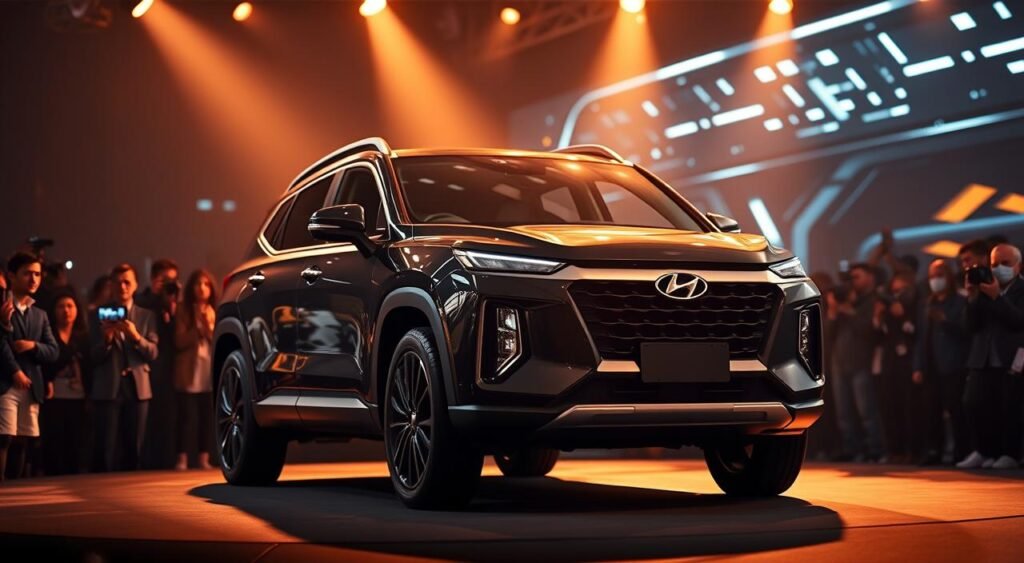
Key Features of Santa Fe Elite
The Santa Fe Elite is loaded with luxury features for comfort and ease. Inside, you’ll find leather seats and heated front seats that adjust electrically. The car also has a big 12.3-inch touchscreen and a top-notch 12-speaker Bose sound system.
It stands out with its storage options. The vehicle offers:
- Spacious central console compartments
- Triple glovebox configuration
- 642 liters of boot space
- Wireless charging pads for two devices
Technical Specifications
The Santa Fe Elite has a 2.5-liter turbocharged engine. It makes 206kW of power and 422Nm of torque. An eight-speed automatic transmission and all-wheel drive make it handle well.
It’s also very safe, with 10 airbags and features like autonomous emergency braking. It got a five-star ANCAP rating in 2024. This makes it a great choice for those who care about safety.
Price Range and Variants
The Santa Fe Elite is priced well in the premium MPV market. It comes with cool features like dual-zone climate control and 20-inch wheels in all versions.
New MPV Launch: Model B
The MG QS Essence AWD is a big deal in the MPV world. It brings luxury and practicality together. This makes it a top choice in the Indian MPV market.
Design and Aesthetics
The MG QS Essence AWD has a modern look that stands out. It has full LED lights and 20-inch alloy wheels for a sporty vibe. Inside, you’ll find leather seats that adjust and heat up.

The car has a big infotainment screen and a digital cluster. It also has climate control for all passengers. The second row is special, with seats that slide and recline.
Performance Metrics
The QS has a 2.0-liter engine that’s powerful. It sends power to all four wheels through a nine-speed transmission. But, it uses more fuel than expected, at 11.4L/100km.
Comparison with Competitors
The QS has lots of space and a big warranty. It comes with a 10-year warranty if you service it at MG dealerships. This is a big plus for those looking for value.
The Surprise Entry: A New Player in the Market
This week, the automotive world saw a big surprise. Toyota is now entering the commercial vehicle market with the new Land Cruiser. This move shows Toyota is looking to reach more customers in India, not just private buyers.
Background of the Brand
Toyota’s Land Cruiser has been around for many years, known for its toughness. The new commercial version is designed for today’s needs. It’s built to last, making it a great choice for India’s varied transportation needs.
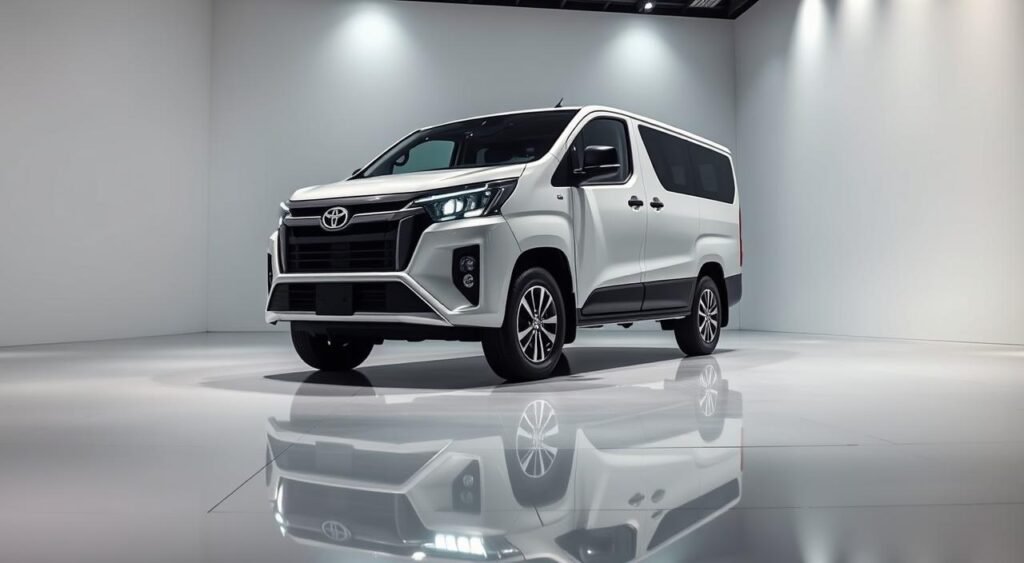
Unique Selling Points
The Land Cruiser commercial version has some key benefits for Indian buyers:
- Proven reliability in tough terrain
- Versatile design for both business and personal use
- Robust build quality for long-term value
- Lower maintenance costs than rivals
- Strong resale value in the commercial market
Market Expectations
Experts think many rural businesses and fleet operators will be interested. The Land Cruiser fills a gap between regular MPVs and heavy-duty trucks. Toyota’s move could change how people buy vehicles for work.
Prices are expected to be competitive, yet the quality will stay high. This shows Toyota gets what India’s commercial vehicle market needs.
Trends in the MPV Segment
The MPV segment in India is growing fast. Families are looking for cars that are both practical and comfortable. They want space without giving up on modern features.
Growing Popularity of MPVs in India
Nowadays, seven-seater cars are all the rage. Buyers want cars that are easy to store things in and comfortable for everyone. The Hyundai Santa Fe is a great example, with its smart storage and easy-to-reach console.
People care a lot about safety. They want cars with advanced safety features, lots of airbags, and stability control. Car makers are now including these features as standard.
Consumer Preferences and Demand
Technology is a big deal when it comes to buying cars. New cars come with big screens, wireless phone connections, and top-notch sound systems. This shows how important tech is to buyers.
Warranty is also key. MG’s 10-year warranty is a game-changer. It’s making other companies think about improving their warranties. Prices are important too, with cars like Hyundai’s turbo and hybrid options appealing to different buyers.
The latest car trends show people want:
- Good fuel efficiency and power
- Flexible seating for all family sizes
- Smartphone integration
- Good prices without missing out on features
Impact on the Automotive Industry
The recent 2 mpvs & 1 surprise entry! have changed the game in India’s car market. These new models make old ones think about their prices and features. Now, everyone wants to offer more for less money.
Effects on Existing Models
Old MPV makers are facing big decisions with these surprise car launch newcomers. They must adjust their prices to keep up. Here’s what’s happening:
- Older MPV prices are being tweaked
- More safety features are now standard
- Warranty programs are getting a boost
- Financing options are becoming more flexible
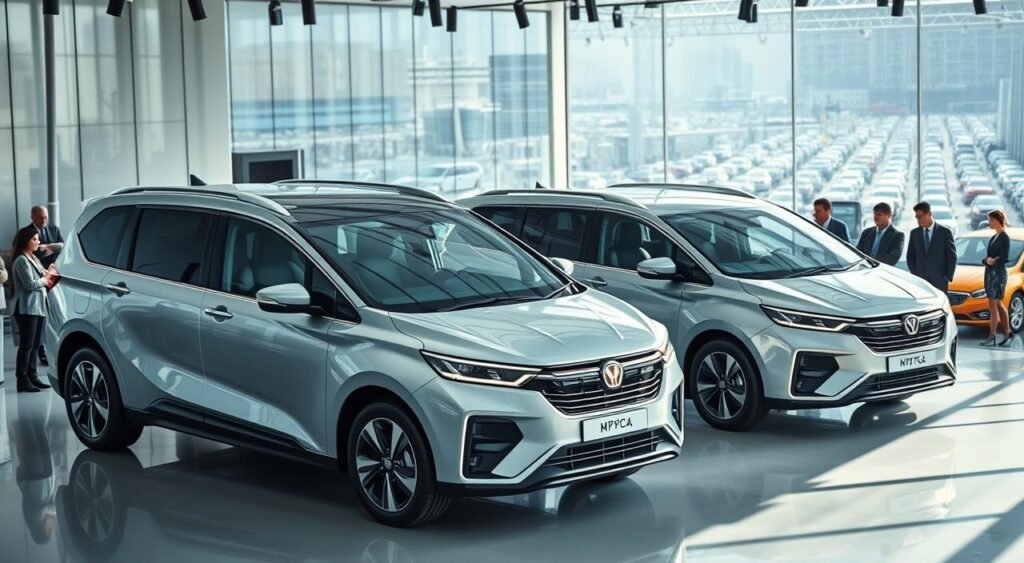
Predictions for Future Launches
The success of these 2 mpvs & 1 surprise entry! shows what’s next. Cars will be roomier and use less fuel. They’ll also have new tech like dual-clutch transmissions.
Expect cars to come with more safety features as standard. The surprise car launch trick is working. Makers will aim to mix performance, efficiency, and affordability in their future cars.
Customer Reactions and Reviews
The car world is buzzing with talk about new car launches this week. People in the industry and on social media have mixed feelings about the latest cars in Indian showrooms. Both experts and those interested in buying have shared their opinions on these new models.
Early Feedback from Experts
Car critics have tested these new cars and given their thoughts. The Hyundai Santa Fe is praised for its exceptional driving dynamics and smooth ride. Drivers say it’s quiet and handles well on different roads.
The MG QS has impressed with its ride quality, according to reviewers. They like its comfy suspension but say the engine needs more power for quick moves. Both cars get criticized for their safety alerts, which some find too loud and distracting.
Social Media Buzz
Online, people are talking a lot about these new cars. Hyundai Santa Fe owners like the easy-to-use controls and climate buttons. But MG QS buyers are upset about the climate controls being hard to find on the touchscreen.
Users are also excited about the Hyundai’s storage solutions. They’re sharing creative ways to use the car’s compartments. People say the cars’ fuel efficiency is as good as promised. They also like the safety features, but many turn off the loud alerts right away.
Conclusion and Future Outlook
This week, the Indian market saw a shift towards versatile family vehicles. New car launches show how makers are trying to meet different needs. They use new tech and smart pricing to stand out.
Each new car brings something special to the market. They set new standards in the MPV and SUV categories. This means buyers can look forward to better options in their price range.
Summary of Key Takeaways
The Hyundai Santa Fe Elite caught attention with its strong 2.5-liter engine. It appeals to those who want power and safety. MG’s QS model shook up the seven-seat SUV market with its low price and lots of features.
Toyota’s Land Cruiser commercial variant meets the needs of those looking for heavy-duty vehicles. These launches show how well makers understand what Indian buyers want.
What to Expect Next Week
More exciting car launches are on the way. Sources hint at electric and hybrid models coming soon. This week’s prices suggest we’ll see more value in the future.
Buyers should look out for more car events. Expect to see better tech, fuel efficiency, and more choices in popular models. The Indian car market is buzzing with activity, as makers try to meet growing demand for modern, feature-rich cars.
FAQ
What are the latest car releases featured in this week’s automotive updates?
This week, we see three big debuts. The Hyundai Santa Fe Elite now has a 2.5-litre turbo engine. The MG QS Essence AWD is a budget-friendly seven-seat SUV. And, the Toyota Land Cruiser has a new commercial variant.
What is the pricing for the new Hyundai Santa Fe Elite?
The Hyundai Santa Fe Elite starts at ,500. It’s ,500 cheaper than the hybrid model. Yet, it has all-wheel drive and seats seven people.
What are the key specifications of the MG QS Essence AWD?
The MG QS Essence AWD has a 2.0-litre turbo engine. It makes 153kW and 360Nm. It also has a nine-speed automatic, 20-inch wheels, leather seats, and a big infotainment screen.
How do the new MPV launches compare in terms of performance?
The Hyundai Santa Fe Elite has more power, with 206kW and 422Nm. The MG QS has 153kW and 360Nm. Reviews say the Santa Fe is faster and handles better.
What warranty coverage do these new vehicles offer?
The MG QS has a 10-year warranty at authorized dealerships. The Hyundai Santa Fe has a standard warranty, but details vary by market.
What are the fuel consumption figures for these new models?
The MG QS uses 11.4L/100km in real tests, more than its claimed 8.8L/100km. The Hyundai Santa Fe Elite is generally more fuel-efficient.
What safety features are included in these new launches?
Both cars have lots of safety tech. The Hyundai Santa Fe Elite has 10 airbags and a five-star ANCAP rating. The MG QS also has many driver assistance features.
What is special about the Toyota Land Cruiser commercial variant?
The Toyota Land Cruiser commercial variant is made for tough use. It’s designed for rural and commercial needs. It’s perfect for fleet operators and businesses needing reliable transport.
